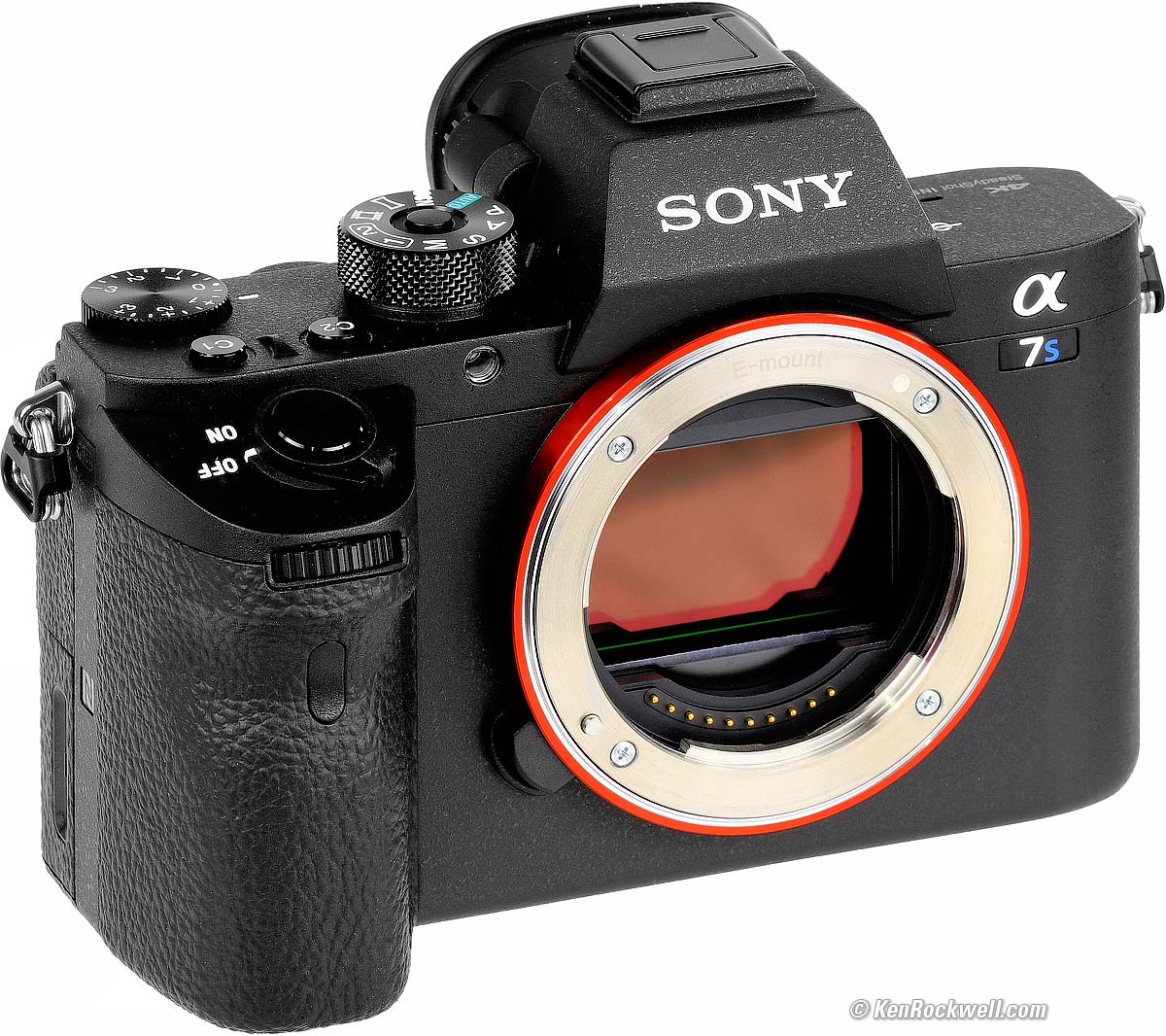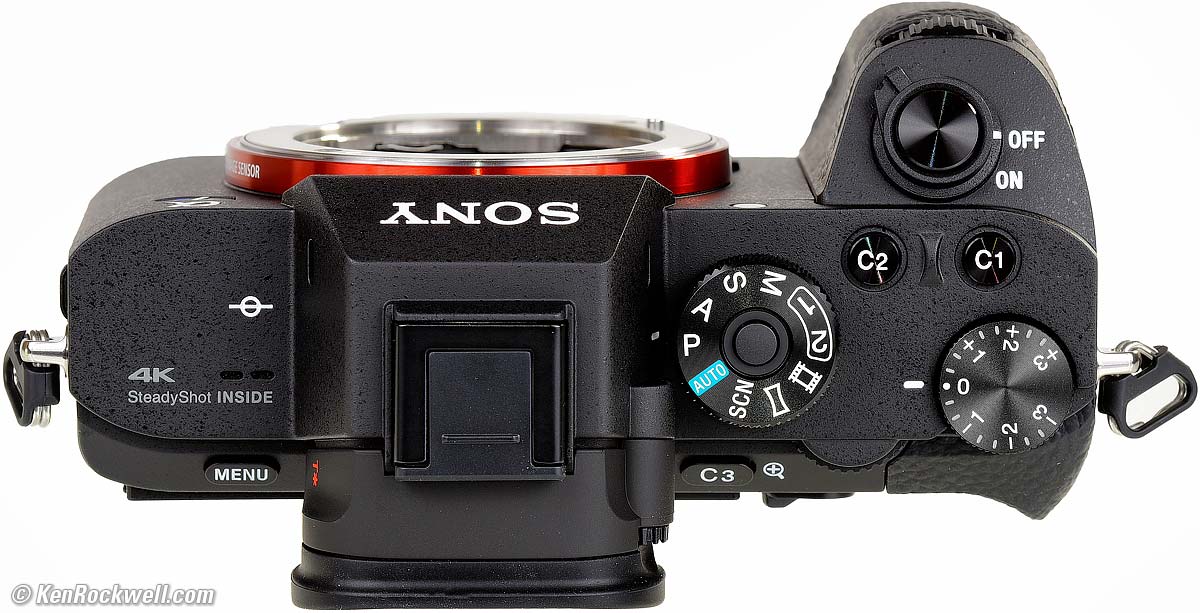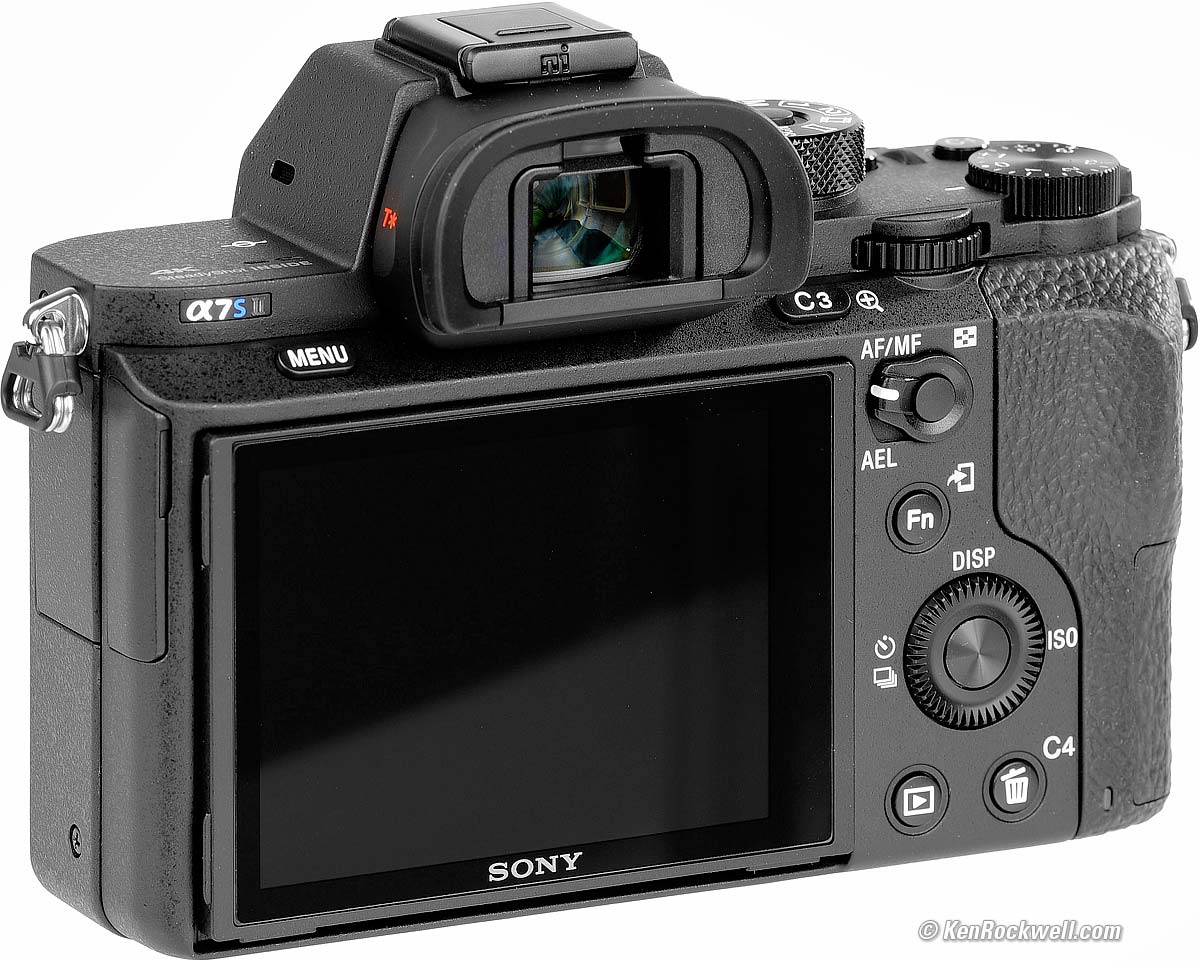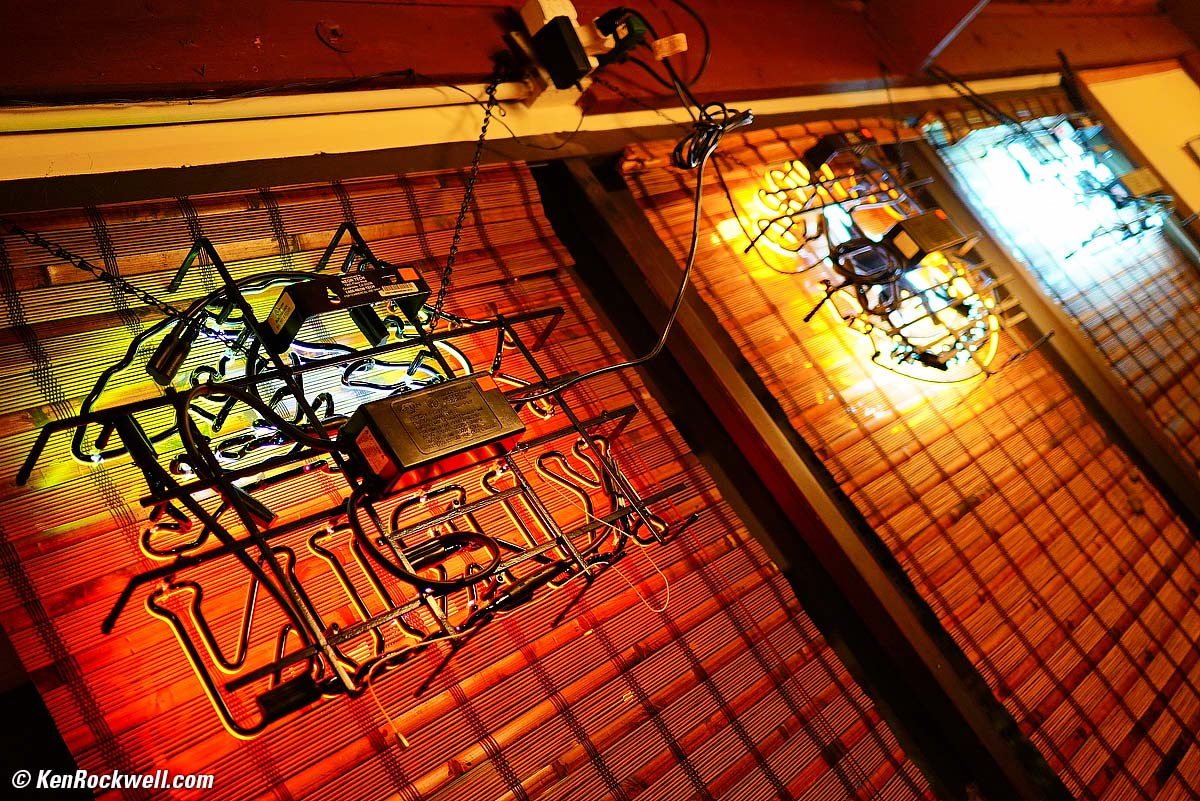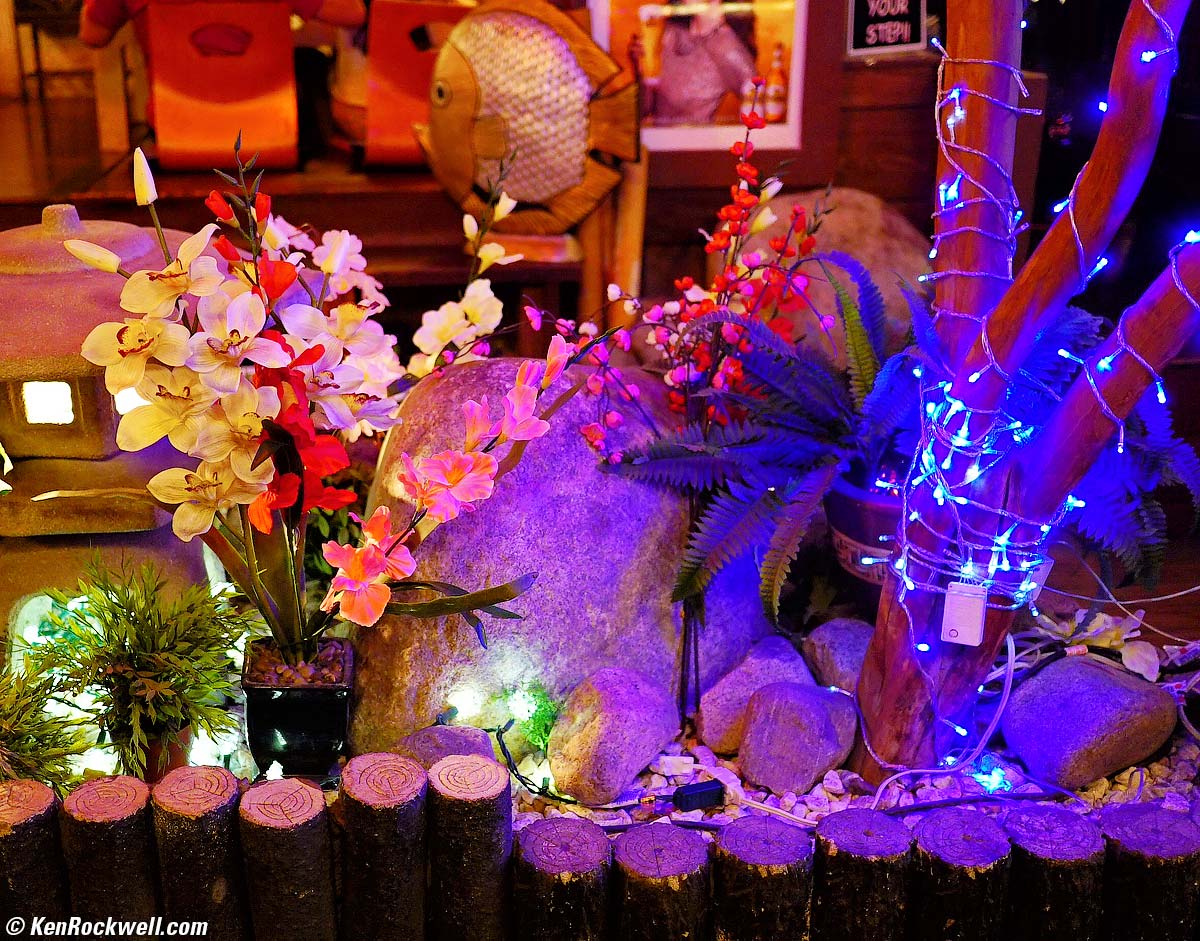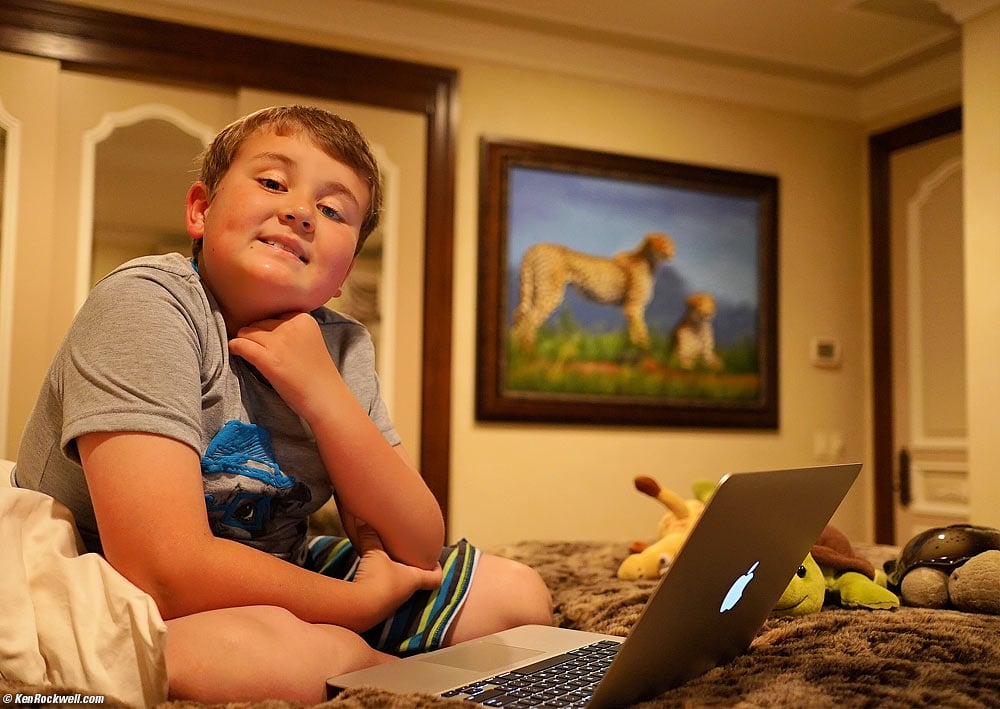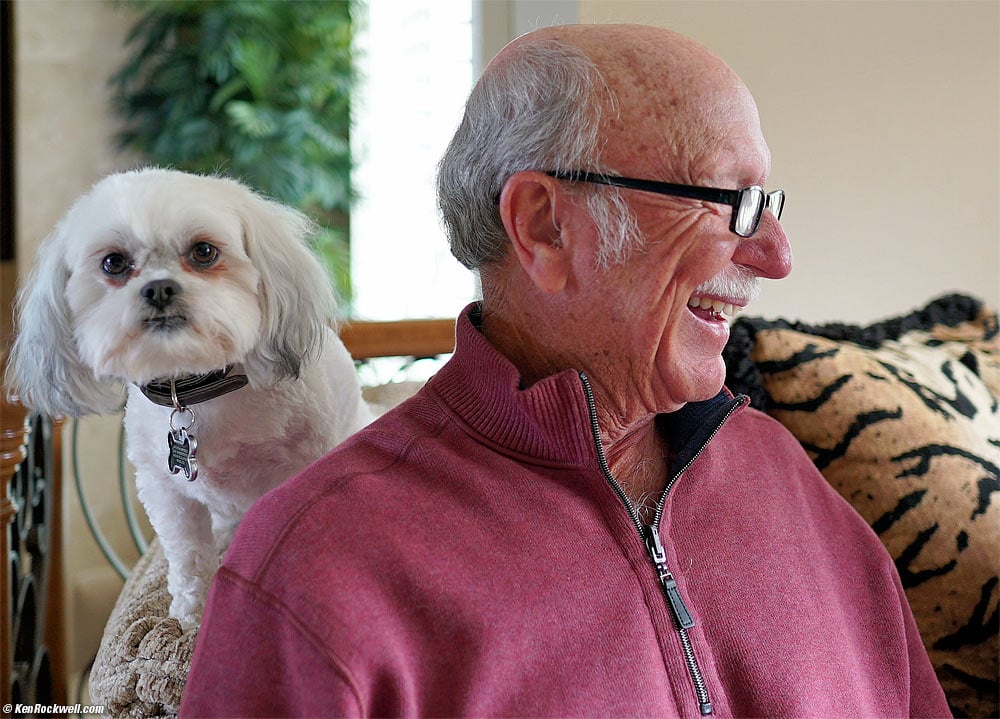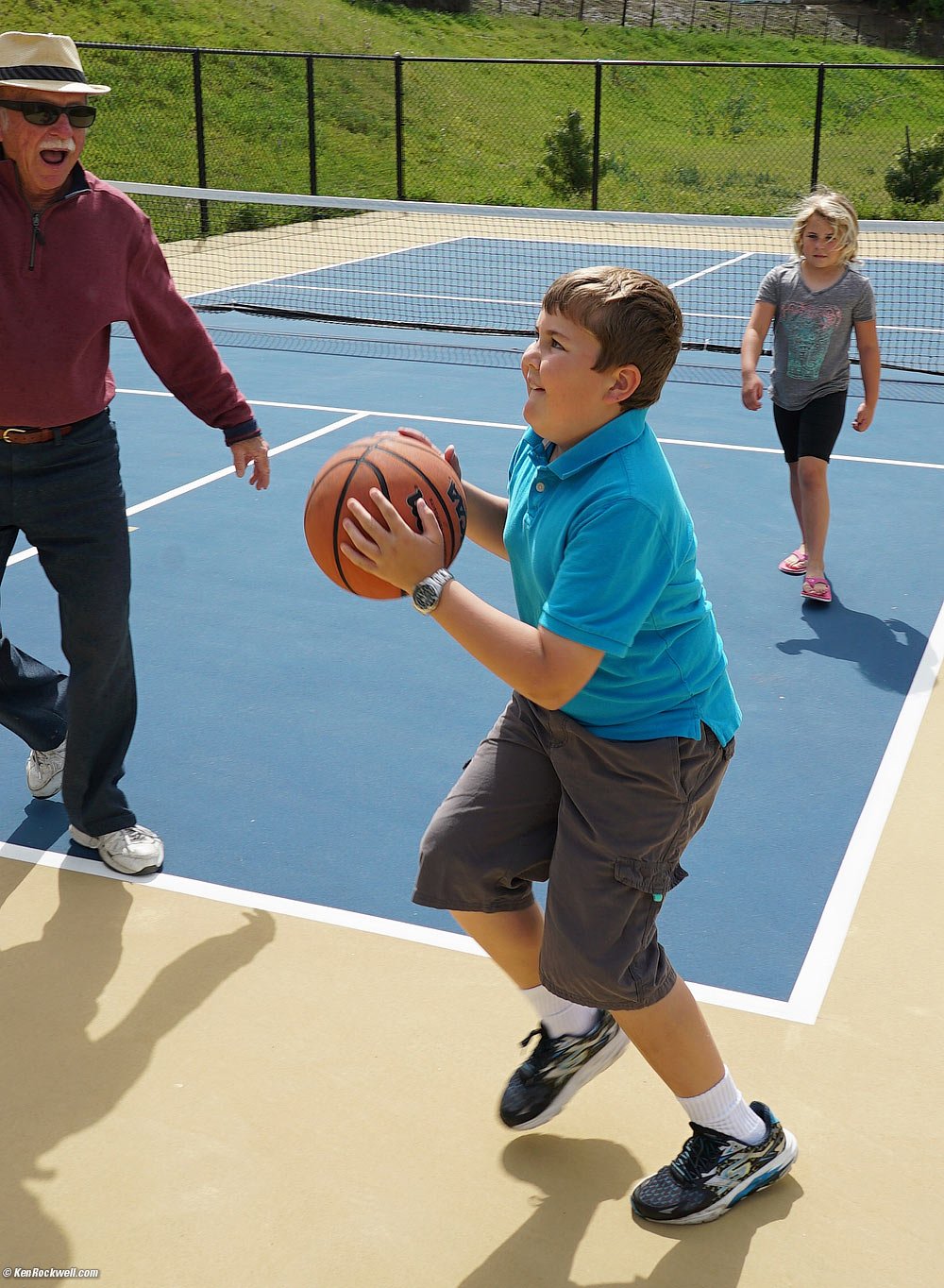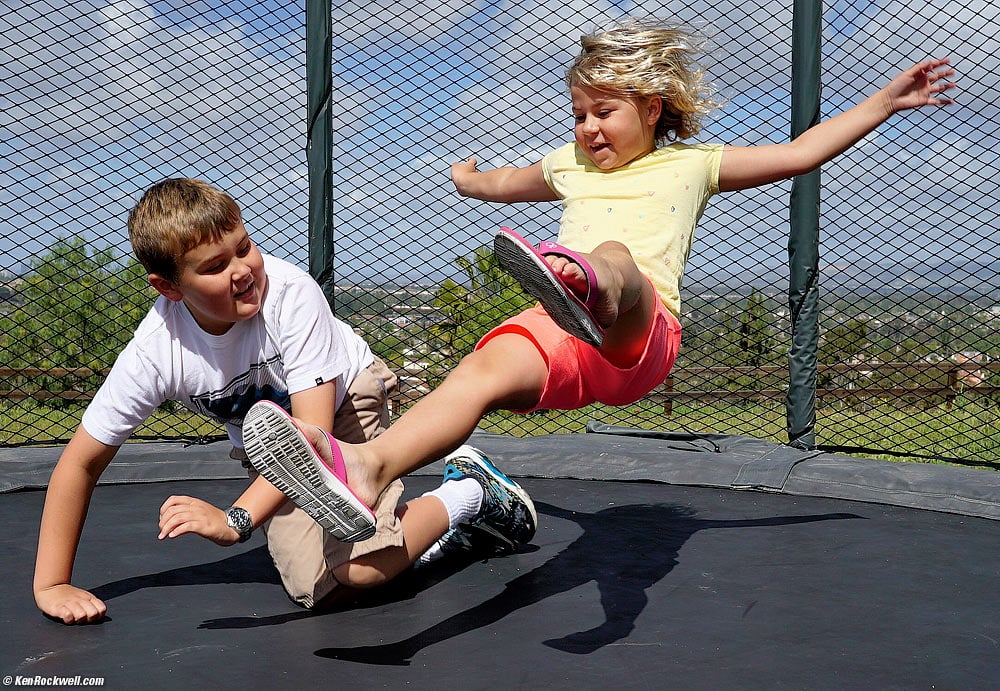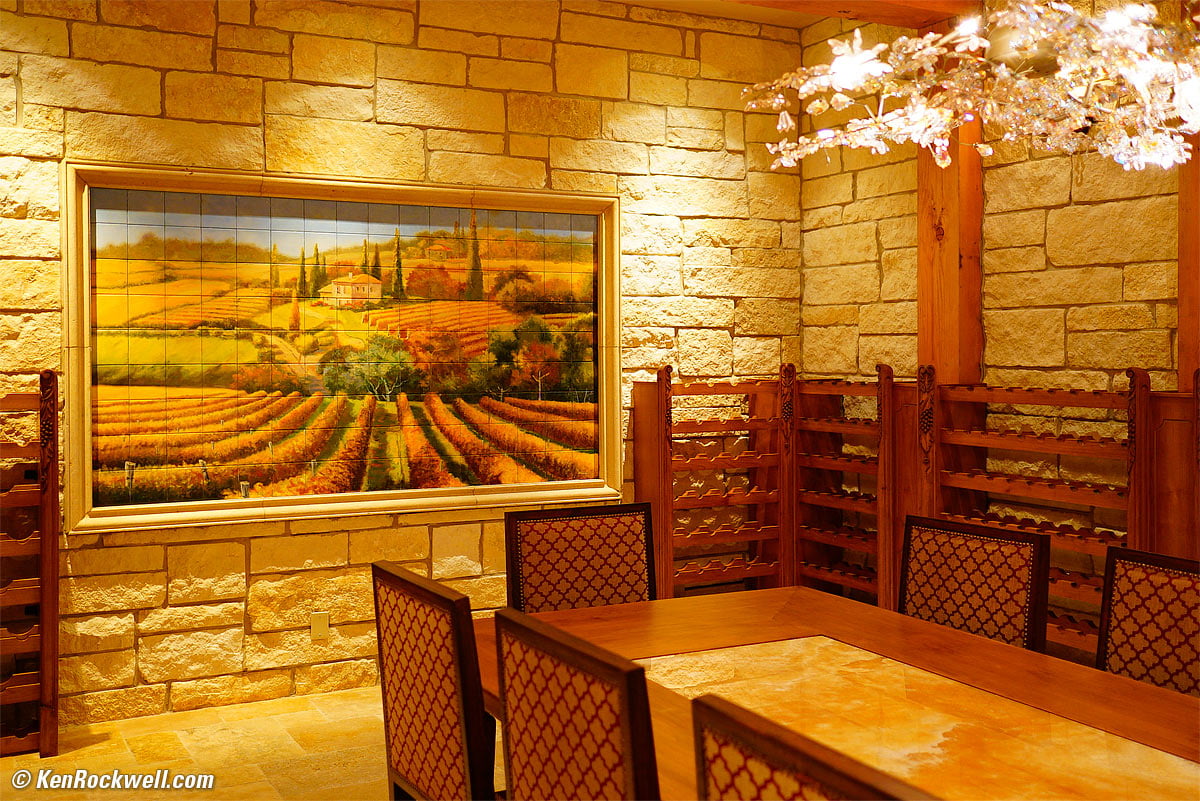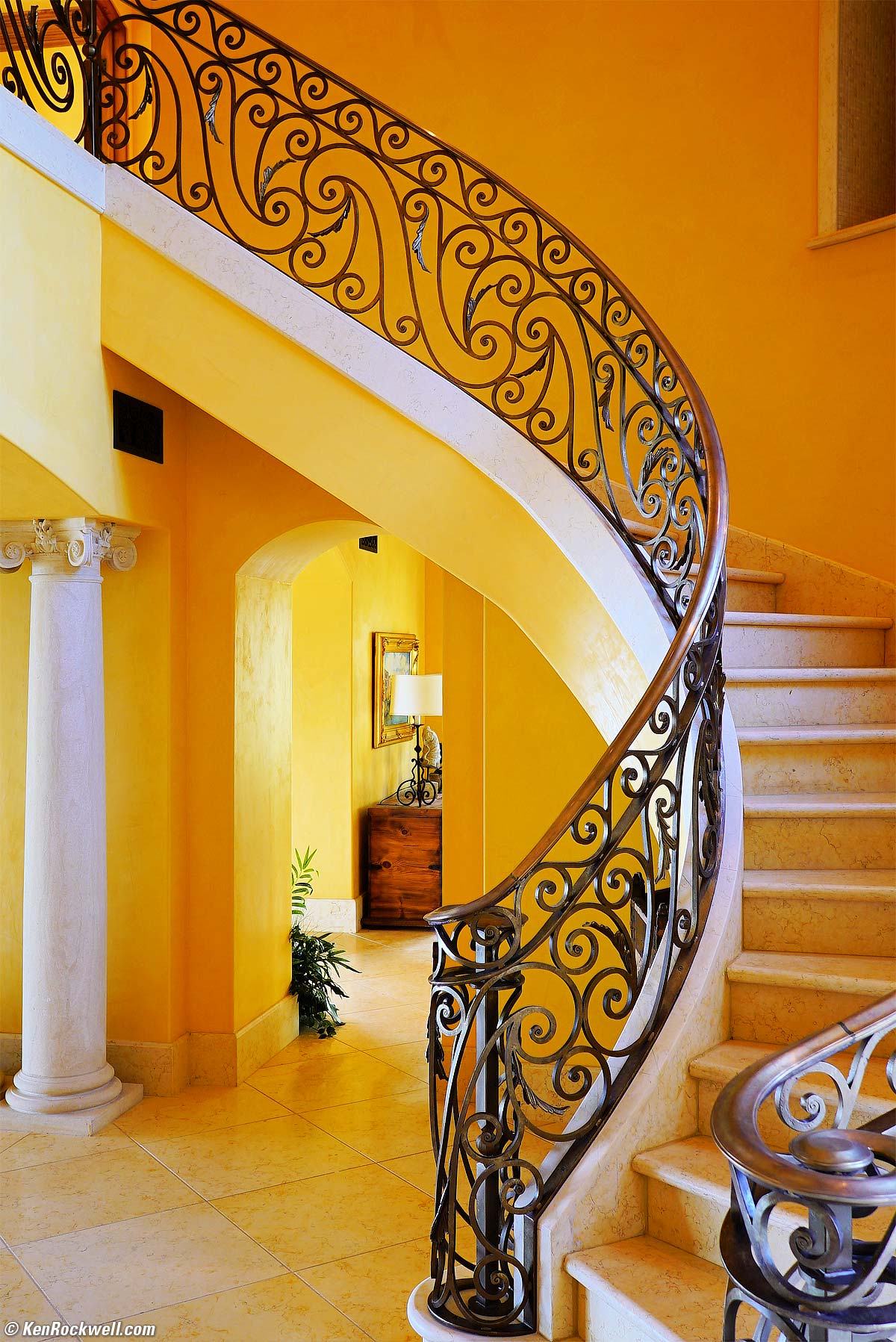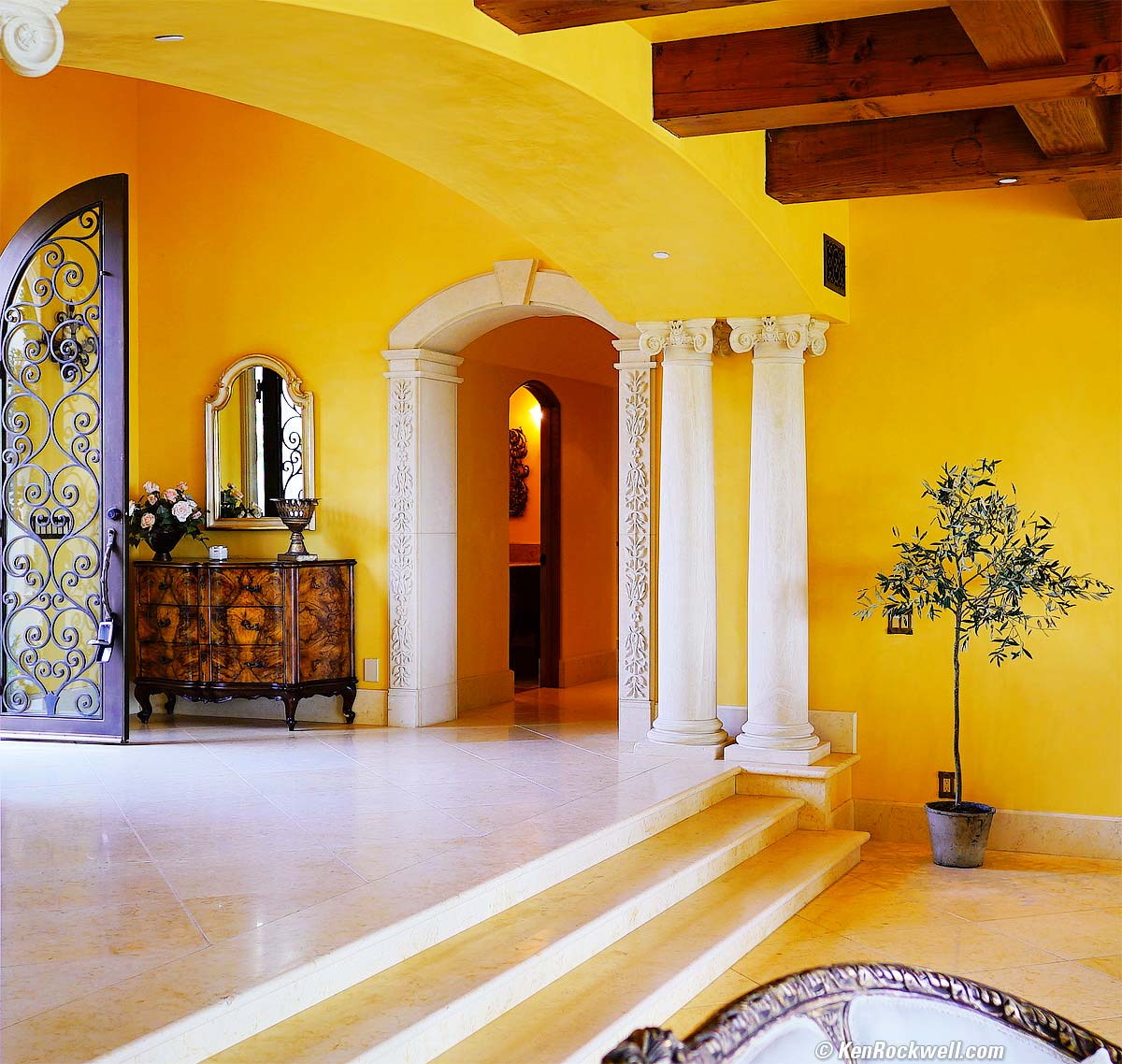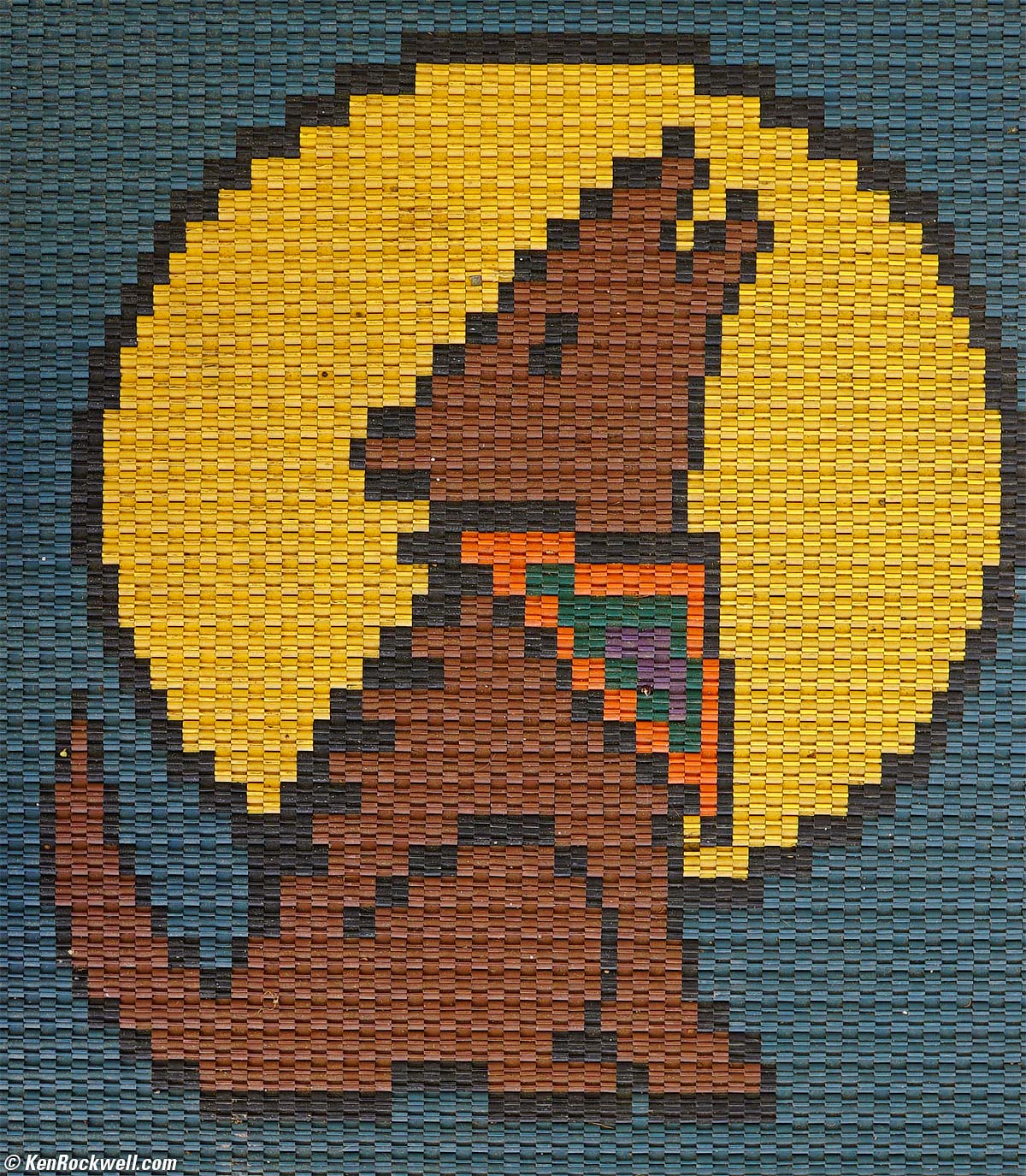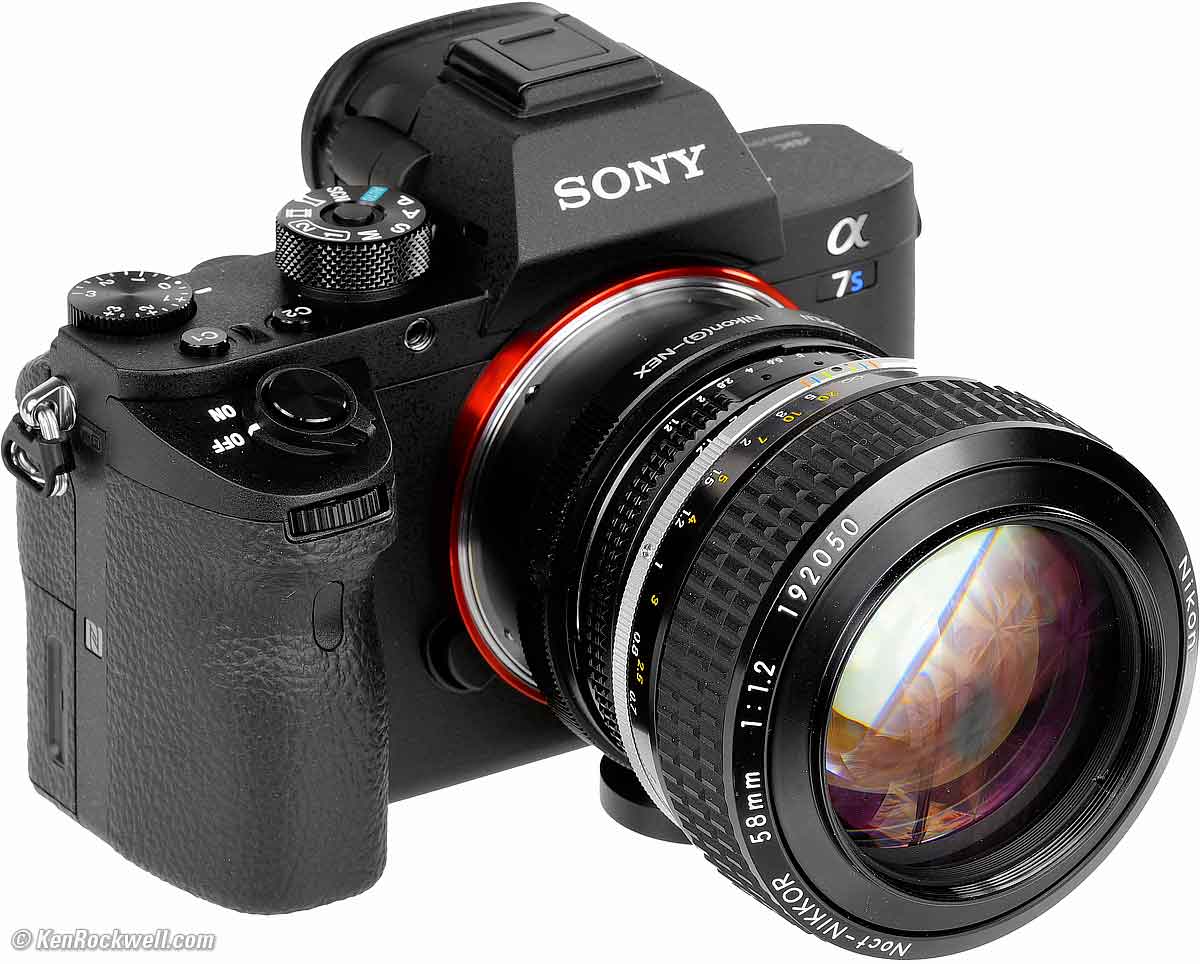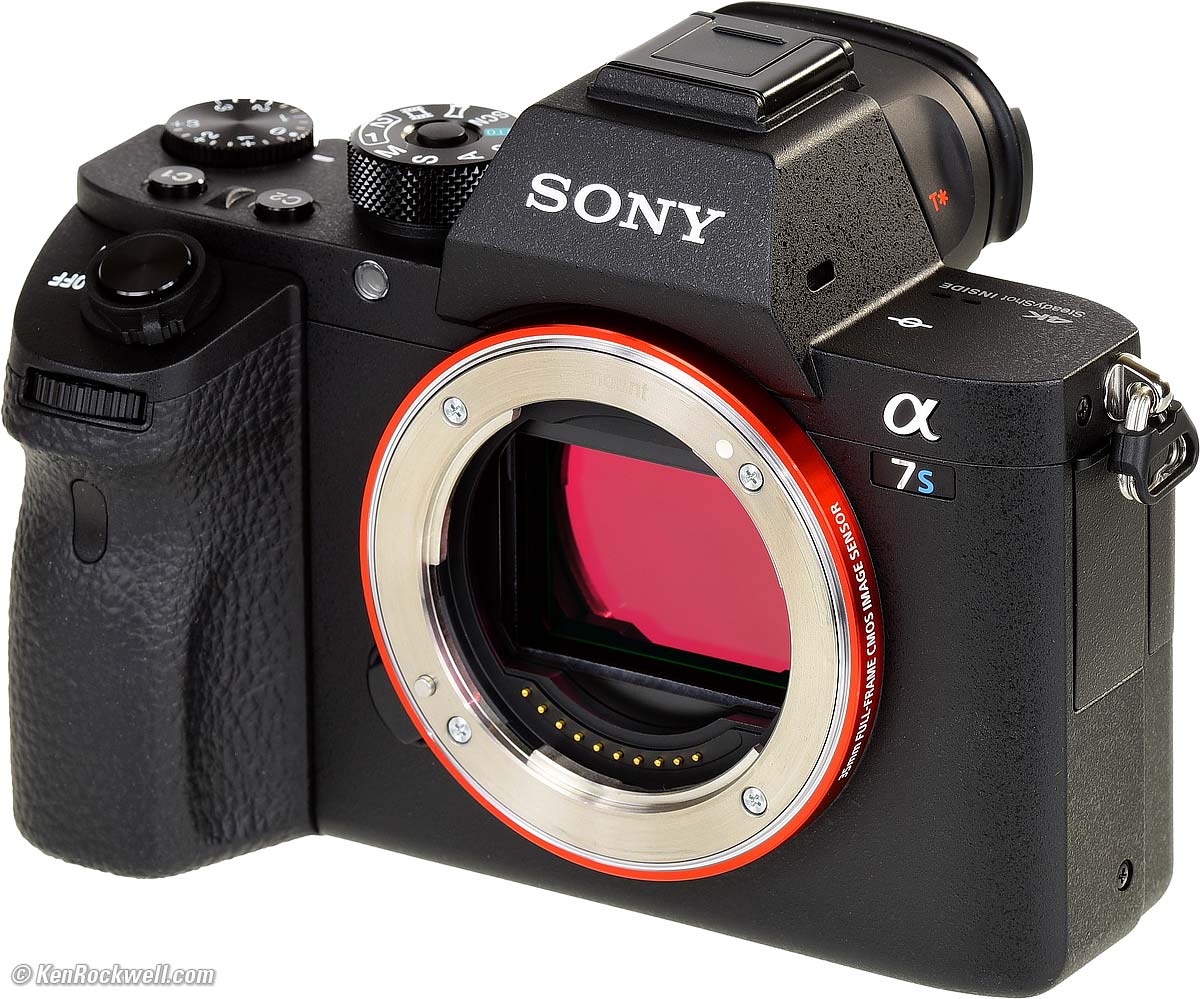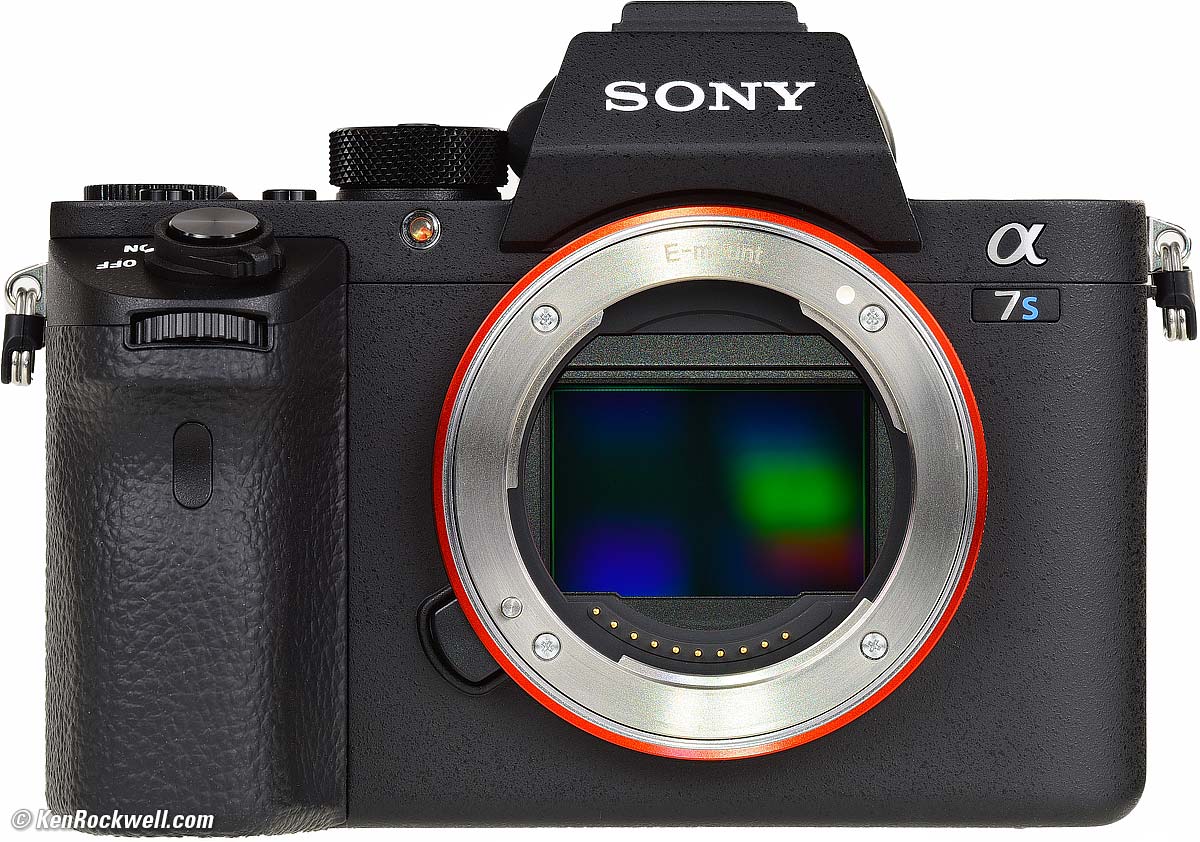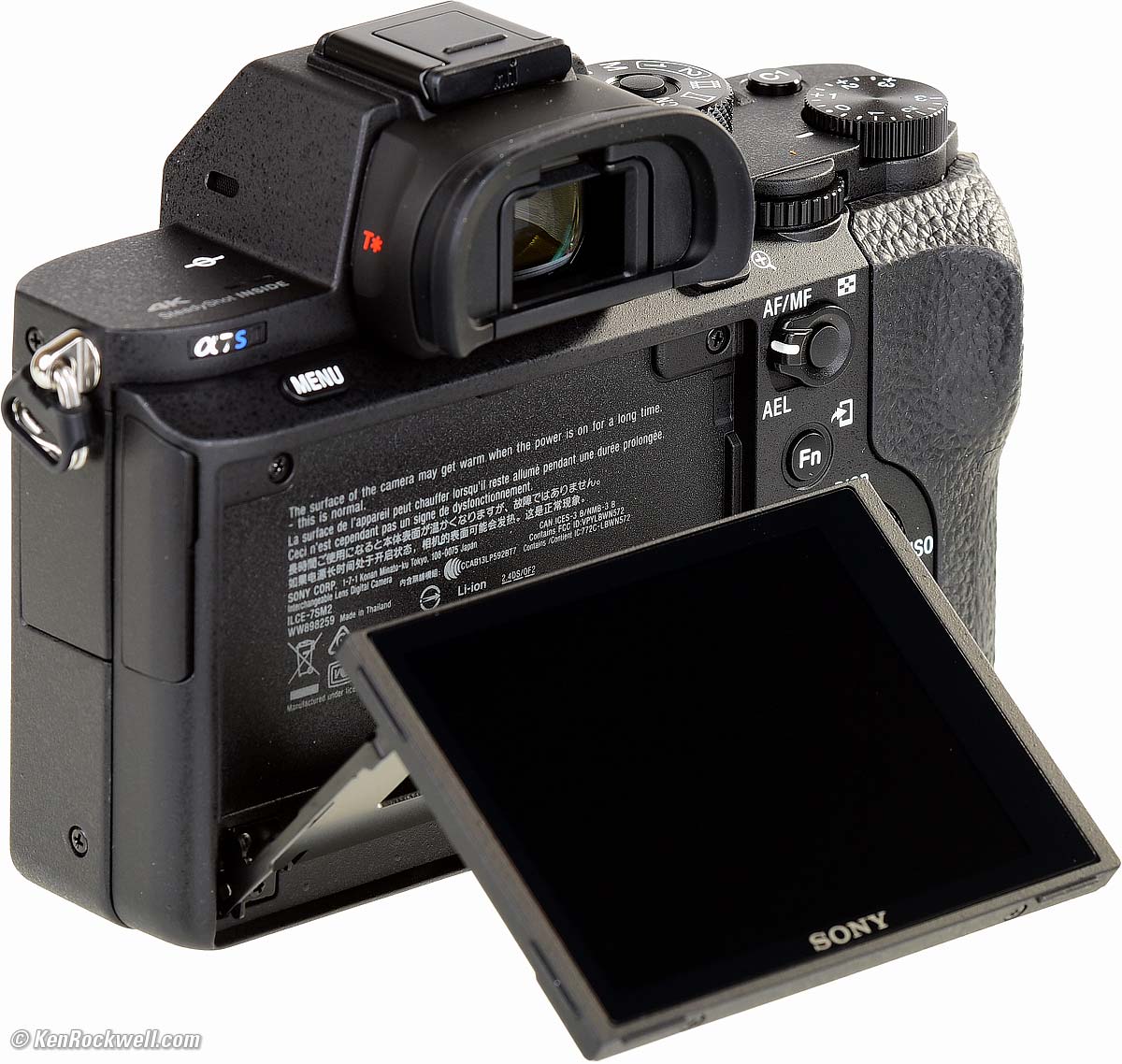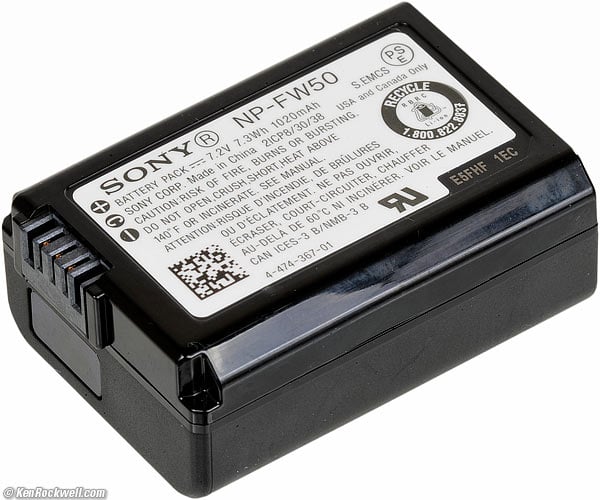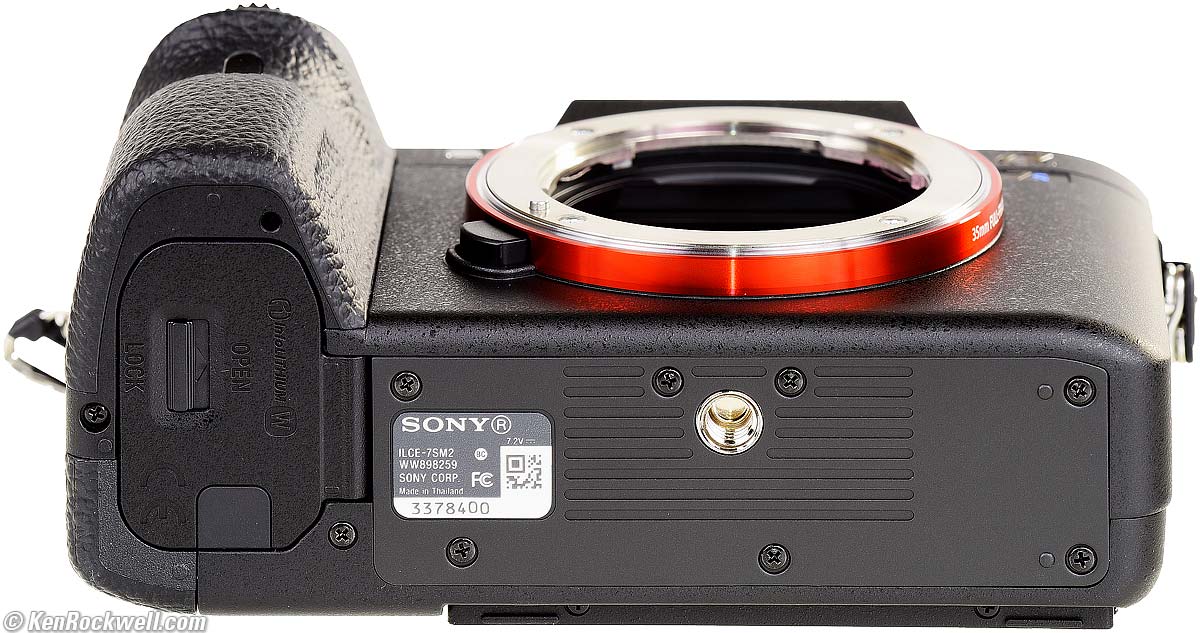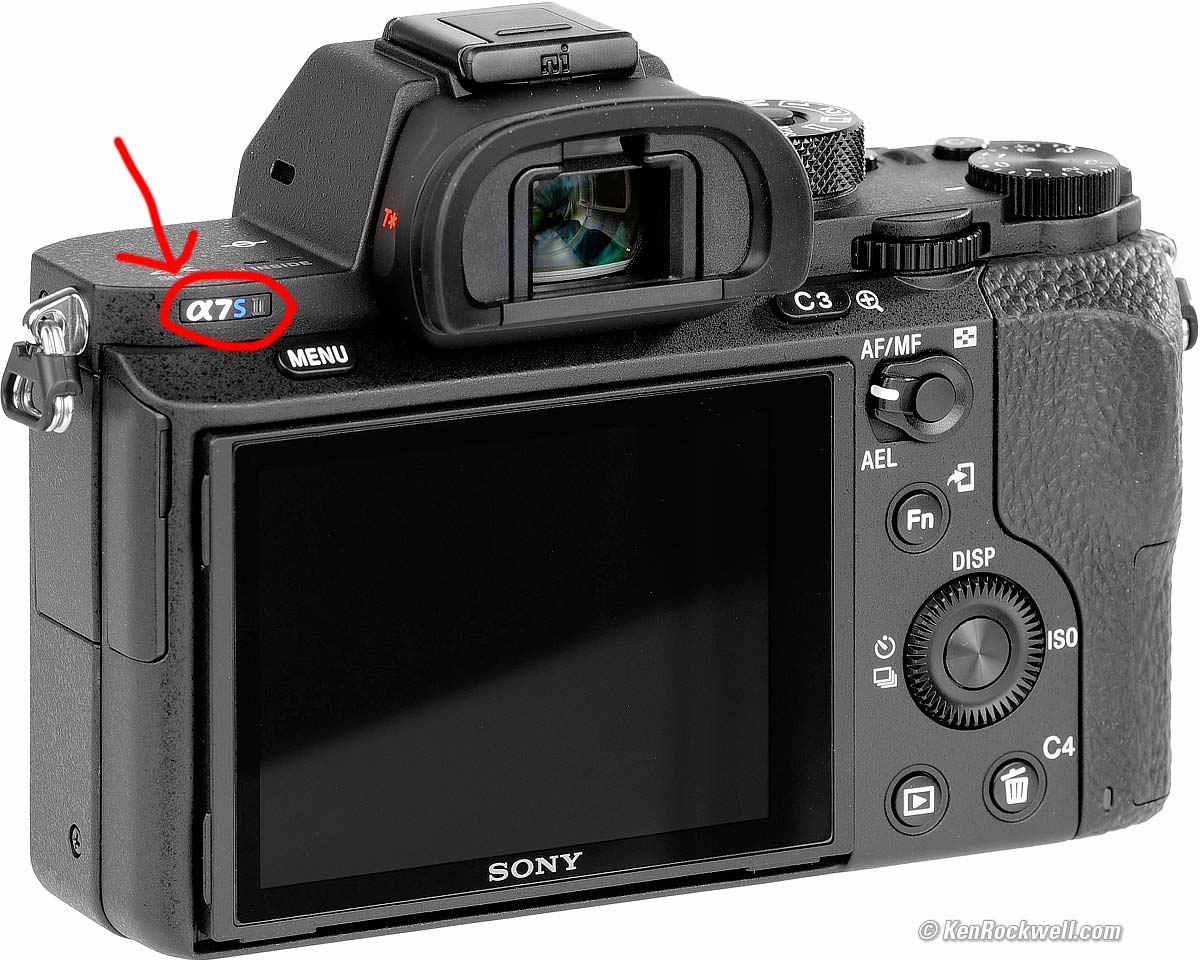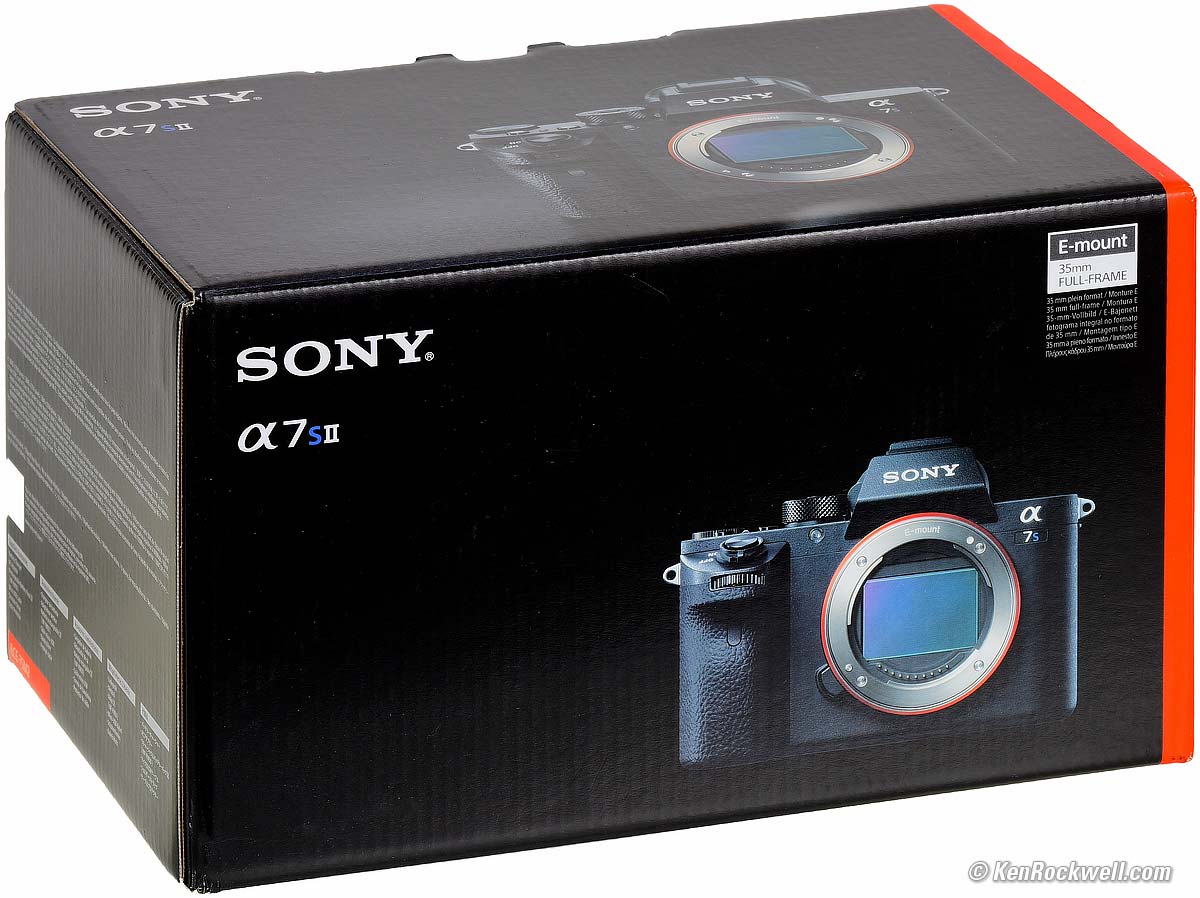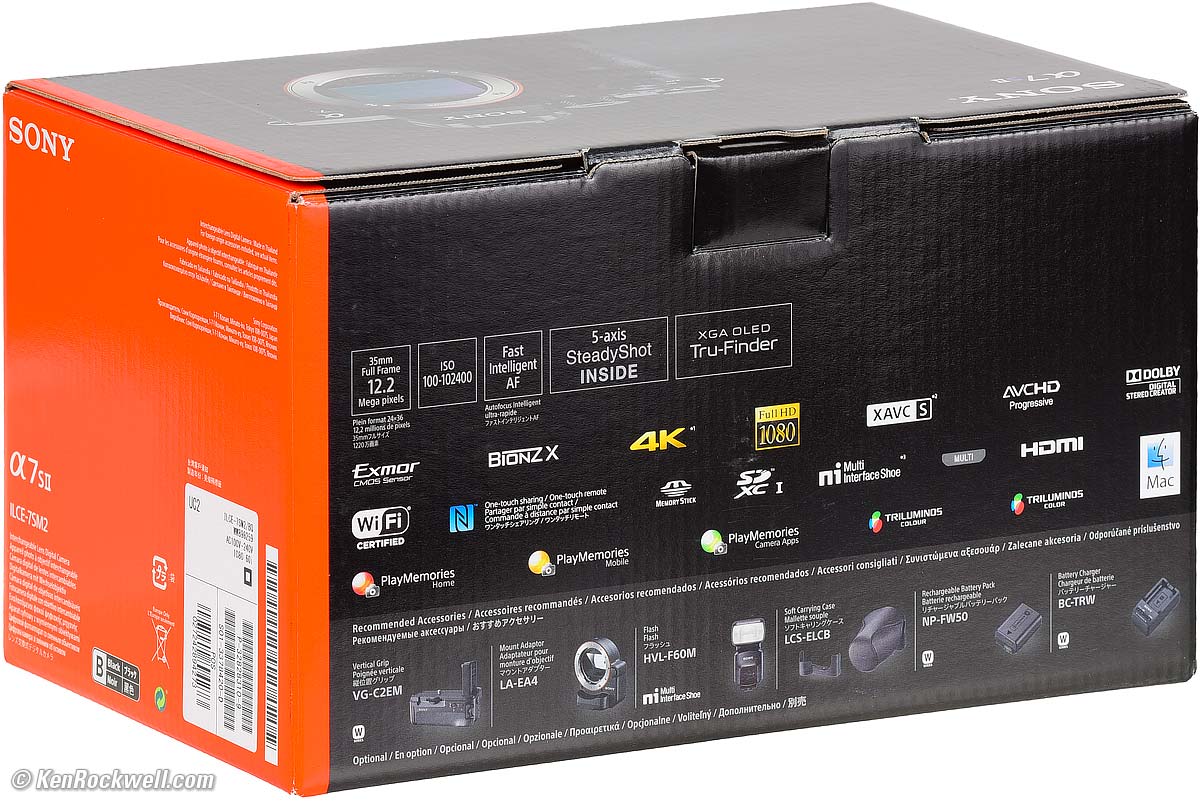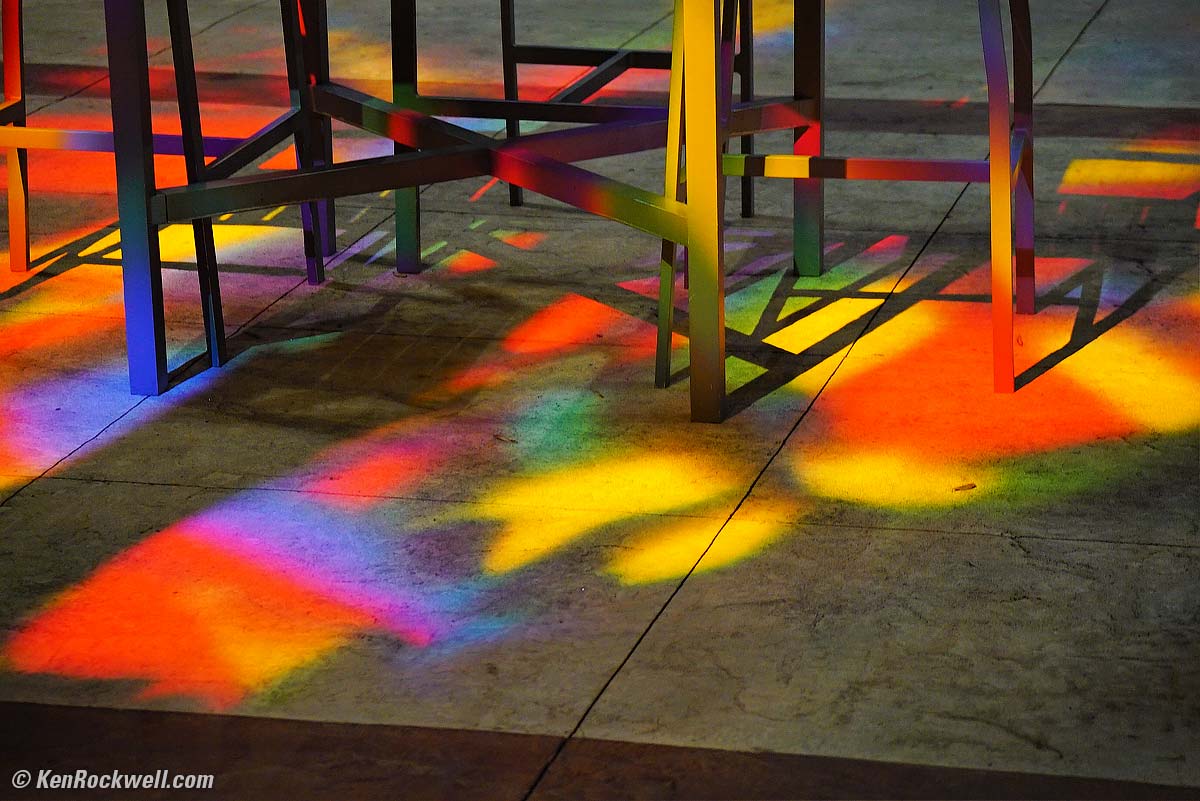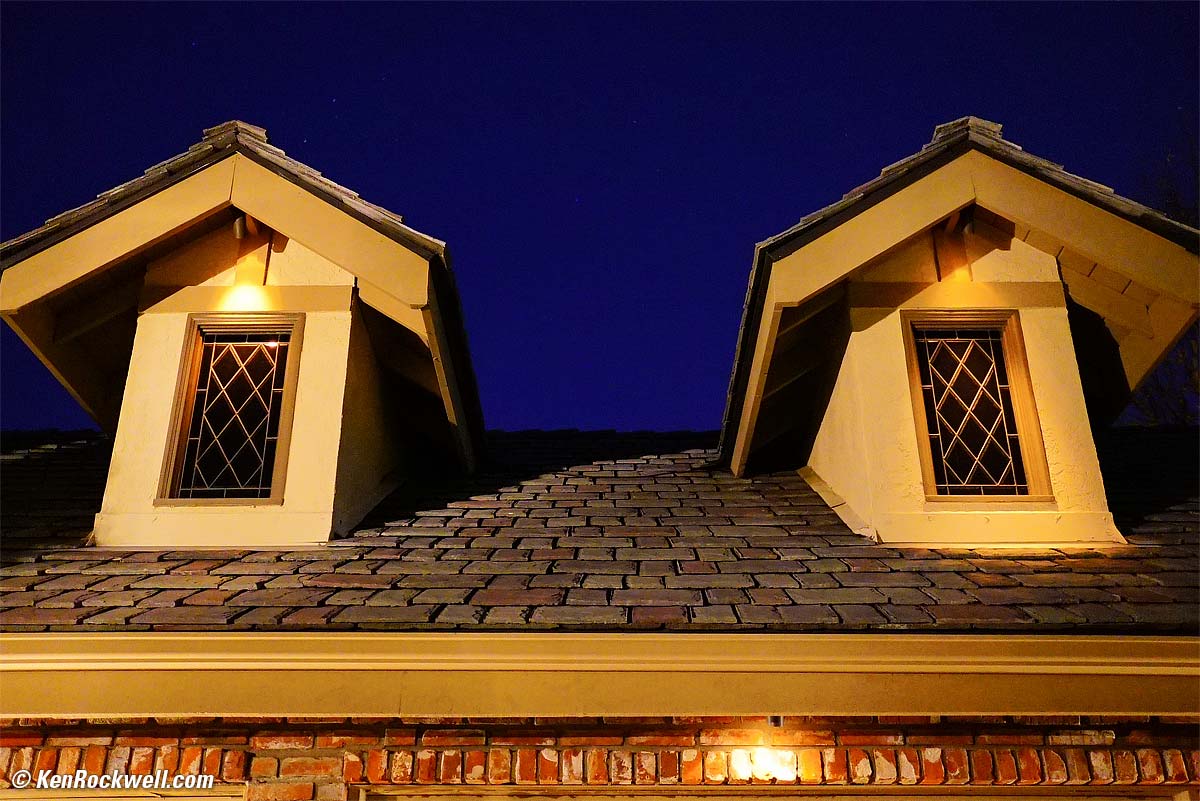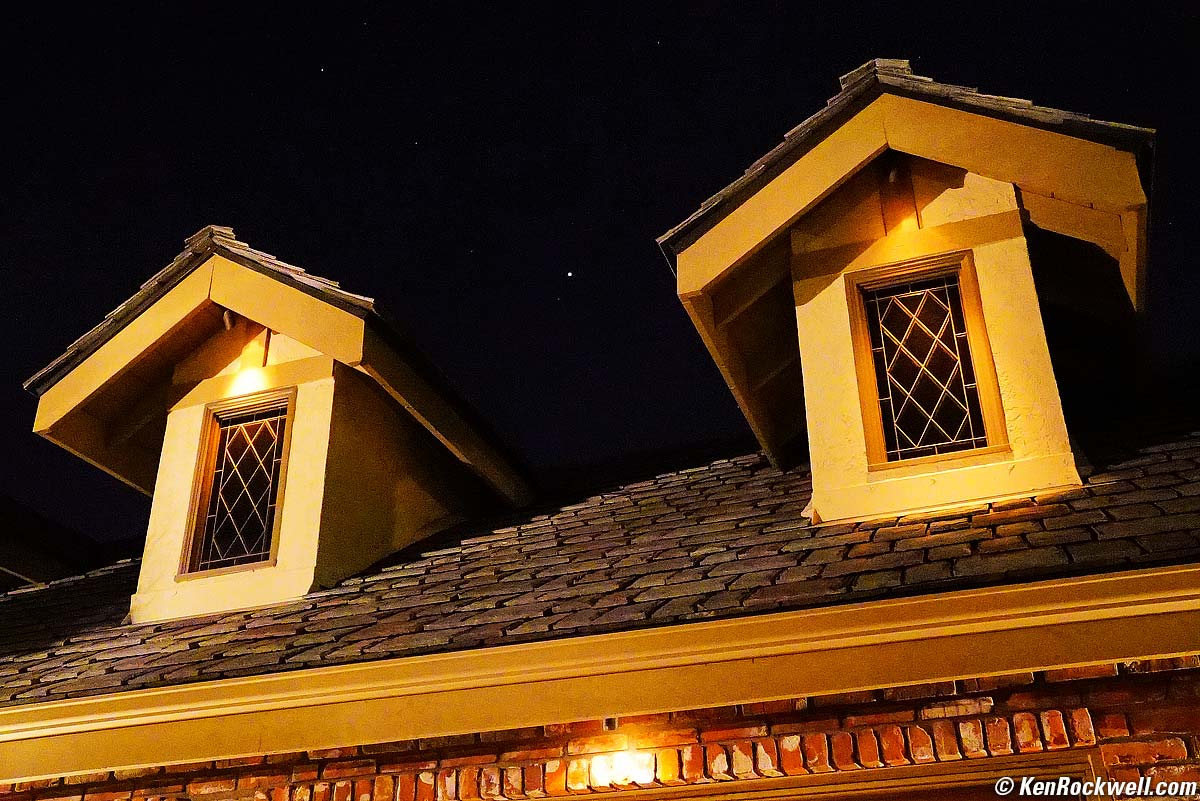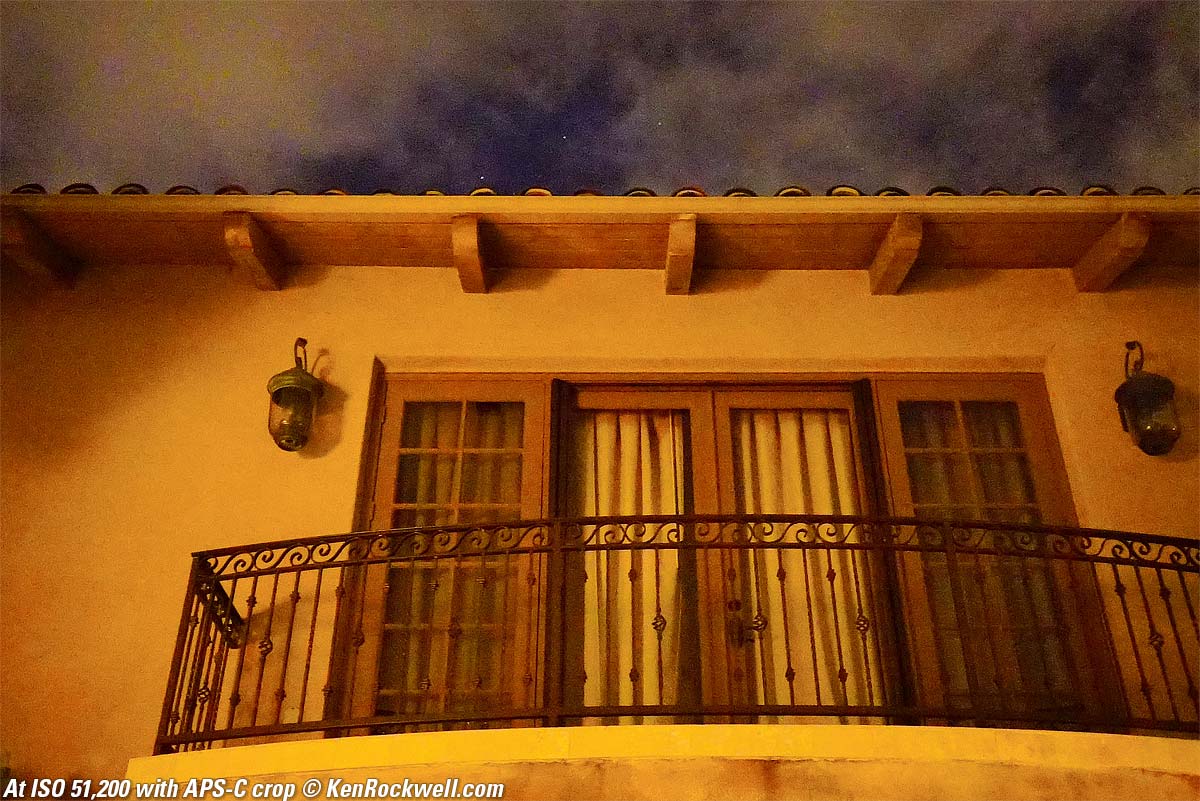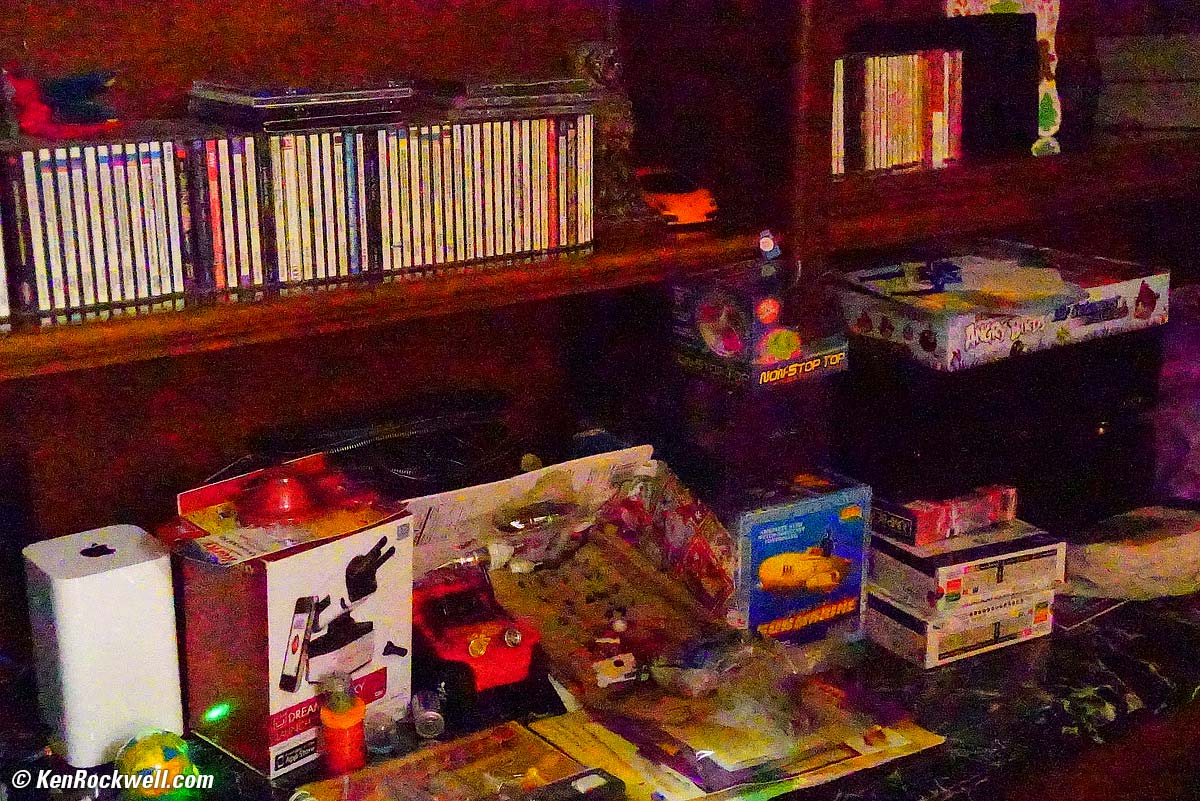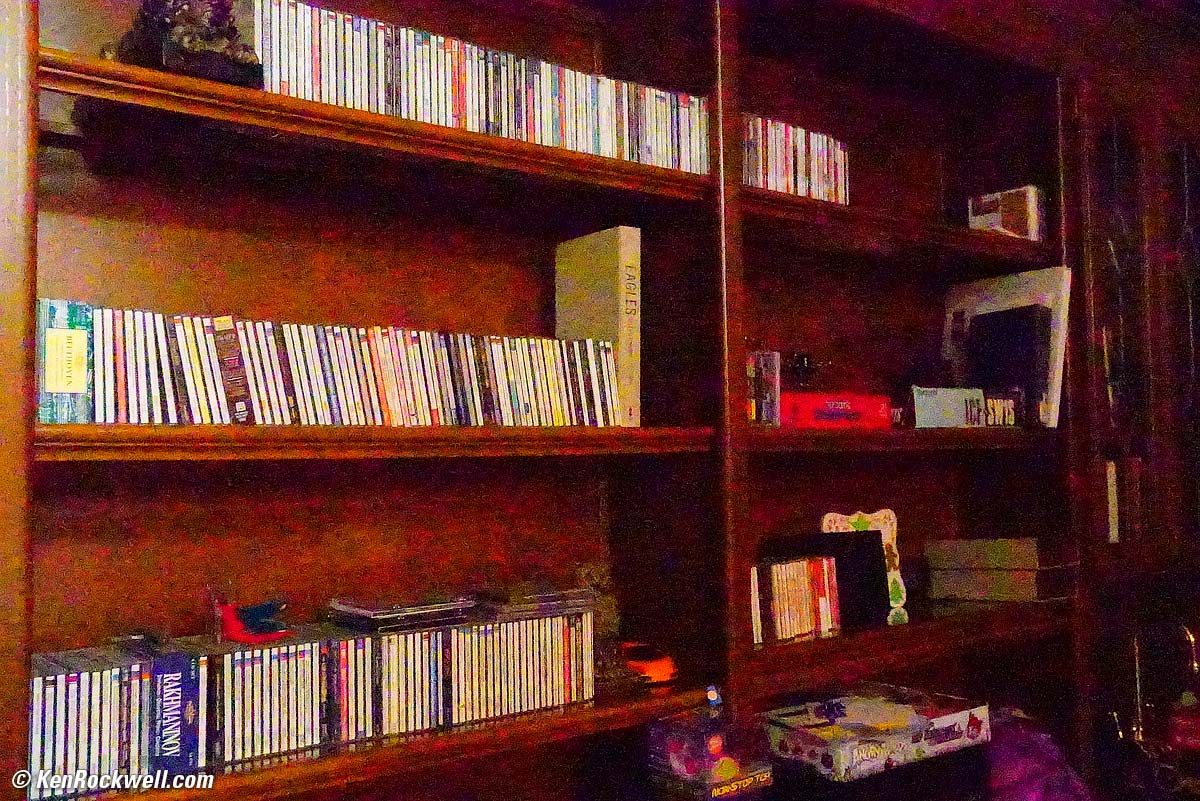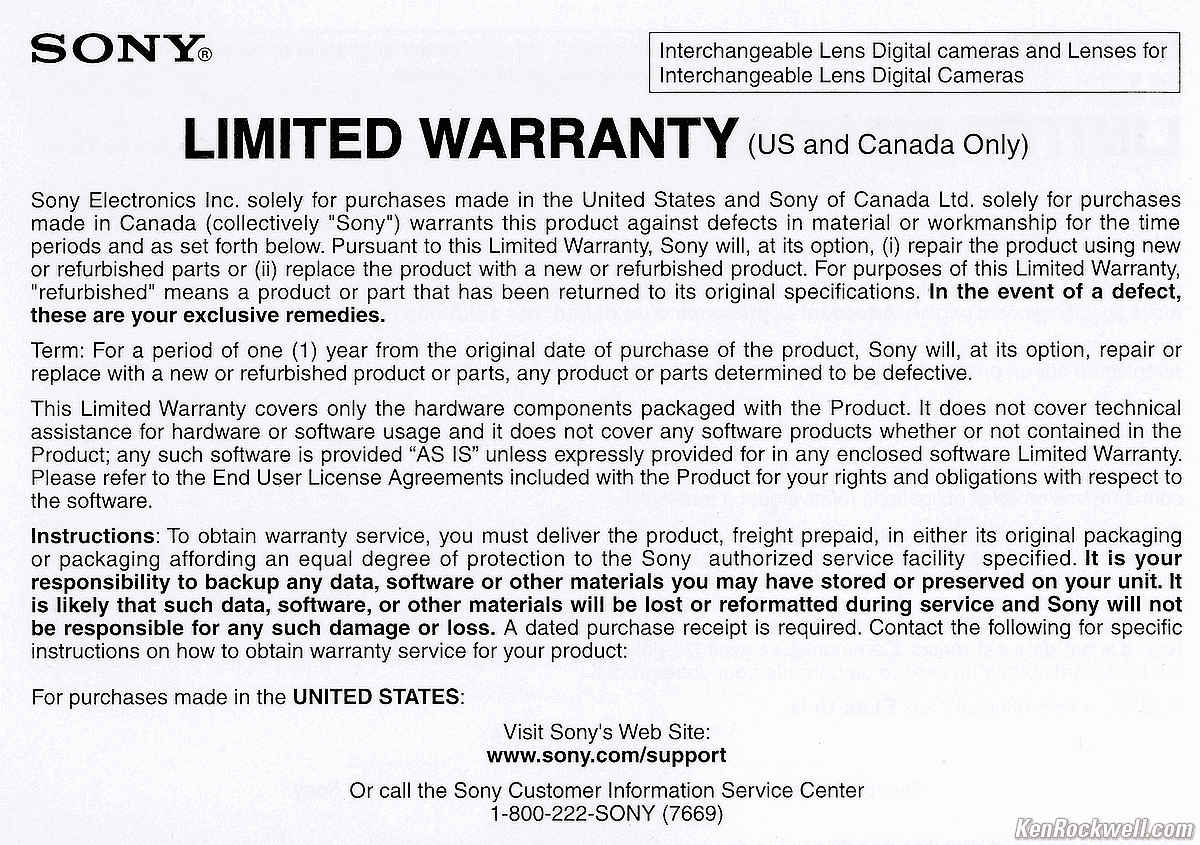Home Donate New Search Gallery Reviews How-To Books Links Workshops About Contact
Sony A7S II
12MP Full-Frame 5 FPS, 4K Stereo
Sample Images Intro Lenses & Adapters
Specs Performance Legal USA Version
Compared Usage Recommendations More
Sony: A9 III A1 A9 II A9 A7R V A7R IV A7R III A7 IV A7 III A7R II A7S III A7c A7 II A6600 A6400 A6100 A6000 ZV-E10 RX10/4 RX100/7 RX100/6 Flash Lenses
Sony A7S II (22.3 oz./631 g with battery and card, about $2,998). bigger. I got mine at Adorama; I'd also get it at Amazon, at B&H or at Crutchfield.
This all-content, junk-free website's biggest source of support is when you use those or any of these links to my personally-approved sources when you get anything, regardless of the country in which you live. Sony does not seal its boxes in any way, so never buy at retail or any other source not on my personally approved list since you'll have no way of knowing if you're missing accessories, getting a defective, damaged, returned, store demo or used camera. Buy only from the approved sources I use myself for the best prices, service, return policies and selection. Thanks for helping me help you! Ken.
March 2016 Sony Zeiss Nikon Canon Fuji LEICA All Reviews
NEW: All Sony Cameras Compared
Sony A7S II. enlarge.
Sony A7S II. enlarge.
Sample Images top
Sample Images Intro Lenses & Adapters
Specs Performance Legal USA Version
Compared Usage Recommendations More
Nori Neon, 04 March 2016. Sony A7S II, Zeiss 24mm f/1.8 at f/2 for 1/60 at Auto ISO 800. bigger or © camera-original file to explore on your computer (mobile devices rarely can display these at full resolution).
Nori Fountain, 04 March 2016. Sony A7S II, Zeiss 24mm f/1.8 at f/2 for 1/60 at Auto ISO 1,250. bigger.
Ryan, his MacBook Air and the Mr. Turtle Family, 04 March 2016. Sony A7S II, Zeiss 24mm f/1.8 at f/2 at 1/60 at Auto ISO 1,250. bigger.
Pops and Sasha, 05 March 2016. Sony A7S II, Zeiss 24mm f/1.8 at f/2 at 1/60 at Auto ISO 250. bigger.
Pops, Ryan and Katie playing basketball, 05 March 2016. Sony A7S II, Zeiss 24mm f/1.8 at f/8 at 1/320 at Auto ISO 100. bigger.
Ryan and Katie on the trampoline. Sony A7S II, Zeiss 24mm f/1.8 at f/8 at 1/500 at Auto ISO 100, Perfectly Clear. bigger.
Wine Cellar, 05 March 2016. Sony A7S II, Zeiss 24mm f/1.8 at f/2 at 1/15 hand-held at Auto ISO 250. bigger.
Staircase, 05 March 2016. Sony A7S II, Zeiss 24mm f/1.8 at f/4.5 at 1/13 handheld at Auto ISO 100. bigger or © camera-original file to explore on your computer (mobile devices rarely can display these at full resolution).
Yellow interior, 05 March 2016. Sony A7S II, Zeiss 24mm f/1.8 at f/2.2 at 1/60 at Auto ISO 100. bigger or © camera-original file to explore on your computer (mobile devices rarely can display these at full resolution).
Introduction top
Sample Images Intro Lenses & Adapters
Specs Performance Legal USA Version
Compared Usage Recommendations More
This Sony A7S II is Sony's best camera. It's fast and sure, and shoots in the dark. It's so sensitive that I can see more detail in the dark through its finder with an f/4 lens than I can see with my naked eye! Not only does it see better than my own eyes, it has no problem focusing in the pitch dark with no need for an AF illuminator.
It's better than the almost identical Sony A7R II because this A7S II works faster and costs less. Either has more than enough pixels for anything, while the A7R II suffers from pixel bloat (42 MP) that slows down many camera operations like playback, but adds nothing to 99% of the things for which people use digital images. 12 MP is enough for anything and lets the A7S II work faster than the 42 megapixel A7R II. If you think 12MP is any kind of limitation, come see me and I'll show you outstanding 20 x 30" (50 x 75 cm) prints made from 12 MP cameras.
Want to know a secret? All the samples here are shot in the 5 MP APS-C crop mode, and look great at any size.
The A7S II also has higher ISO settings than the A7R II.
Another huge advantage of this A7S II over the A7R II is that while both are genuinely silent, the A7R II only runs silently in single shot mode, while I can run at 5 FPS in continuous advance mode as well on my A7S II. Otherwise, these two are the same camera.
The best part about this Sony A7S II (and the A7R II) are its outstanding silent mode that actually is completely silent. It's hidden in the GEAR 5 menu, and makes this a top choice for those of us who like to shoot without being noticed.
It is completely silent when set this way. It is so silent I can photograph people standing at arm's length who are telling me not to take their picture, and they know that I didn't take their picture because they hear nothing as I shoot away. This is a huge benefit for people who have to shoot near people and prefer not to be noticed.
Never mentioned by Sony, but my A7S II appears to shoot-through flickering fluorescent and dimmed LED lighting with no problems: no of-color or randomly dark frames even when I've tried deliberately, in Silent mode.
The A7S II is smaller and lighter than most, but not all, DSLRs, but when you add full-frame lenses to it, it loses most of the weight advantage. With a 50mm or 55mm f/1.8 lens, some full frame DSLRs like the Canon 6D actually weigh the same or less.
The A7S II shoots and autofocuses very quickly. Everything works very quickly and very well, but unfortunately its industry's worst menu system means that it takes a very long time to get it set up as you want it.
Most of the time when you need to set something, you have to forage through the entire menu system to find it. The menus have nearly no organization, rhyme or reason to them.
Many buttons are programmable, so if you have the patience, you can get it to work extremely well.
It has two memory recalls on its mode dial, 1 and 2, so it's easy to set up one for people pictures (standard color with +1 Saturation and continuous shutter mode and Auto ISO set to 1/125 minimum shutter speed) and the other for landscapes and things (Vivid picture with +3 Saturation, single shot, and Auto ISO set for much slower minimum shutter speeds).
The A7S II makes sharp, high-resolution images (yes, 12 MP is high resolution) and has so many features, fancy specifications and the ability to use so many accessories and different brands of lenses with adapters that it's a photo hobbyist's dream.
Sony A7S II. enlarge.
Good top
● Excellent electronic finder: big, bright, sharp and wonderful.
● Solid metal construction.
● Silent mode really is. It's easy to shoot in sensitive areas and not be noticed.
● Even in regular modes the shutter only moves at the ends of exposures. There's never any need for a special vibration-free mode; it always works this way. Suck on that, LEICA!
● Excellent high ISO performance.
● Great high ISOs and completely silent operation make this an investigator's, peeping Tom's and journalist's dream.
● Facial recognition works well, but only after you find it and turn it on (CAMERA 6 menu).
● In-finder 3-axis level works great for keeping horizons and vertical lines as they should be.
● Comes with two batteries, and they can be charged in-camera via USB or in the included charger.
● Any lens of just about any brand can be adapted in some way to work.
● Stereo microphone built-in.
Bad top
● Lenses on adapters rarely work well.
● Silent mode won't work with flash.
● Battery life is poor, a few hundred shots, but it comes with two batteries.
● The menu system is the worst in the industry. There are way too many items spread all over the place with little organization, so expect to dig through the whole menu system any time you need to find anything.
● The LCD isn't bright enough to see in direct sunlight; it has no auto brightness control (a Canon DSLR is usually much better), but the electronic finder is marvelous in daylight.
● Only runs 5 FPS, not great for sports or action; get the Canon 7D Mk II which runs twice as fast for half the price.
● Unlike a DSLR, it always takes a moment to turn on or to wake up and get ready to shoot. It also tends to run down the battery if you leave it on, while a DSLR goes to sleep and wakes instantly.
Missing top
● No second card slot.
● No built-in flash.
● No way to back up the complete camera state as Nikons can do.
● No auto brightness control for the LCD.
● The superb magic crop button of the Sony A99 is gone. (It resurfaced in the Canon 5DSR as an option for its M-Fn button.)
● No GPS.
● No shutter dial.
● No aperture rings.
● No ISO dial.
● No diagonal scroll on playback.
● Only 1/8,000 max shutter. Even with an electronic shutter there are no ultra high speeds to allow shooting very fast lenses in broad daylight wide-open, like the Fuji X-T10's 1/32,000 shutter.
Pixelated Coyote by Moonlight, 10 March 2016. (It's a door mat, silly.) Sony A7S II, Zeiss 24mm f/1.8 at f/4 at 1/60 at Auto ISO 100. bigger.
Lenses and Adapters top
Sample Images Intro Lenses & Adapters
Specs Performance Legal USA Version
Compared Usage Recommendations More
Sony A7S II and Nikon NOCT-NIKKOR 58mm f/1.2. bigger.
While you can adapt any lens to the A7S II, they won't work as well as native Sony, Minolta or especially the superior Zeiss lenses.
Forget LEICA or Nikon manual focus lenses as shown above; you'll have to operate the diaphragm completely manually! Ideally use a decent Canon EOS to NEX adapter and you'll get full autofocus, auto exposure, EXIF data and diaphragm operation with every Canon lens made since 1987. Better, with a Canon adapter you can use a man's lens like the Canon 50mm f/1 for great results in starlight. The Canon 50mm f/1 doesn't cost much more than the NOCT-NIKKOR 58mm f/1.2, and it's decades ahead in speed and performance. The Nikon NOCT sells for what it does because collectors pay that much, while collectors haven't discovered the Canon 50mm f/1 which still sells for the same price it has for the past 25 years.
The biggest gotcha with the Sony system is that there are very few native lenses for it, and most of Sony's and Minolta's lenses aren't that great; Zeiss, Canon and Nikon make better lenses.
Ultimately the Sony system is limited by its limited lens selection, not this great little camera. It becomes a clunky contraption once you add an adapter. The thing may or may not work that well, and probably won't give you anywhere near the resolution you thought you wanted unless you use the native Zeiss lenses. There are very few Zeiss lenses for this, so we're back to square one if you want optical perfection and flexibility.
Specifications top
Sample Images Intro Lenses & Adapters
Specs Performance Legal USA Version
Compared Usage Recommendations More
Sony A7S II. enlarge.
Sensor
12 MP.
Full-frame 24 x 36mm.
4,240 x 2,832 pixels native.
1.5:1 aspect ratio.
If you mount an APS-C lens, it automatically uses only the APS-C section of the sensor, and offers you 5 MP, 3 MP and 1.3 MP resolution settings.
Short 18mm flange focal distance allows better lens designs than DSLRs do — the same advantage rangefinder cameras have.
ISO
Manual ISO 50 ~ 409,600.
Auto ISO can select from ISO 100 to ISO 409,600. It's extremely flexible and you can set the minimum and maximum ISOs as well as have the slowest shutter speed either fixed or automatically vary as you zoom.
Lens Compatibility
Sony A7S II. enlarge.
Sony E-Mount (NEX).
Use the LA-EA4 adapter to use Sony Alpha and Minolta MAXXUM lenses with perfect autofocus and complete compatibility.
While you can adapt any lens to the A7S II, they won't work as well as native Sony or Zeiss FE lenses, or Alpha or MAXXUM lenses with the LA-EA4 adapter.
It's a full-frame camera, and even better is that it automatically crops and uses only the APS-C section of the sensor if you mount an APS-C lens. Brilliant!
LCD
Flipping screen, Sony A7S II. enlarge.
Power & Battery
Two NP-FW50 lithium ion batteries included.
Sony NP-FW50 battery. enlarge.
Charges via USB in-camera or in the included plug-in charger:
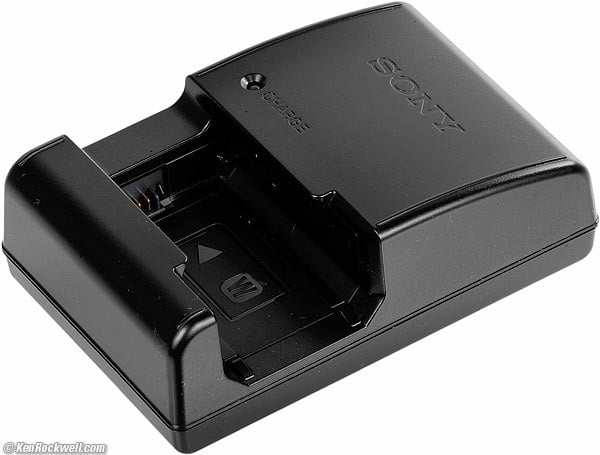
Sony battery charger.
Weight
22.267 oz./631.25 g with battery and card.
(The 42 MP A7R II weighs 22.120 oz. (627.05 g) with battery and card.)
Quality
Sony A7S II. enlarge.
Made in Thailand.
Identification
Different model numbers are marked differently on different parts of the camera.
It's marked "ILCE-7SM2" on its certification sticker on the bottom.
It's marked merely "α7S" on the front.
Sony α7S II. bigger.
The only place to see "α7S II" is on the top left of the back of the camera.
This doesn't matter today, but you'll thank me in 2020 when you're trying to buy or sell one of these second hand.
Available Since
October 2015.
Price
$2,998, September 2015 - March 2016.
Box, Sony A7S II. enlarge.
Box, Sony A7S II. enlarge.
Performance top
Sample Images Intro Lenses & Adapters
Specs Performance Legal USA Version
Compared Usage Recommendations More
Overall
The Sony A7S II is a great camera. Once programed, it's completely silent and shoots fast. It focuses and shoots in any light with ease.
While it has slower handling than a DSLR and not my choice for serious work (it only has one card slot for instance), as a fun hobby camera, it's awesome.
Presuming you shoot it with the Sony ZEISS FE lenses, the system works great. The biggest negatives are a very limited selection of lenses (adapted manual focus lenses aren't a good idea if you care about image quality or convenience, but definitely fun for hobbyists), and Sony's user interface is too sloppy to handle well under pressure for news or sports, but hey, use the real E-Mount Zeiss lenses designed to take full advantage of this mount, and it's awesome.
Autofocus
Autofocus is great: it's fast and accurate.
The Continuous AF mode (AF-C) also works great for tracking motion. Ultimately it's still not as good as a DSLR, but way better than mirrorless cameras have been in the past.
Face recognition works great in all focus modes, but only if you turn it on in the Camera 6 menu!
Individual Face registration is hidden in the Gear 5 menu; I don't bother with that.
Manual focus works much better once you assign the focus magnifier to one of the programmable buttons, otherwise the magnifier comes and goes as it likes.
Finder
The EVF is excellent.
It's sharp, bright and colorful, and it's always the right brightness day or night.
It's life size with about a 63mm lens at 10 meters or a 55mm lens at one meter.
It stays in focus because the finder focus wheel is where it's not likely to get knocked.
Shutter
The silent mode really is. It's fantastic for sneaking around public and private places, or shooting from a blind.
The Silent mode won't work with flash, but unlike the A7R II, also works with the continuous shutter mode.
Even in the regular mode, the shutter only moves at the ends of exposures so there's no vibration.
Frame Rates
Mine really runs at 5 FPS.
At a slower shutter speed of 1/20, I clocked it at 4 FPS. 4 x 1/20 = 1/5, the extra fifth of a second that could have been used for the fifth frame.
Ergonomics
Unlike a DSLR, it always takes a moment to turn on or to wake up.
The A7S2 has essentially no knobs or levers. It has two dials, and the rest is all pushbuttons — and a lot of fiddling in menus. Its only lever is a clever one around the AF/MF and AEL button: the lever selects that button's function. Otherwise, all the actual shooting controls are a few clicks away hidden behind buttons and menus— just like the cheapest Canon SL1 or Nikon D3300. For mirrorless, the Fujis are way ahead with their dedicated dials and levers for actual photography settings like ISO, shutter and aperture — all sorely lacking on this Sony.
It feels clumsy, not at all like a Nikon F6 or Canon 5DS. Things are not where they ought be. It looks OK, but when you put it in your hand and start trying to work it, nothing is properly sculpted to the way a hand works. Too often I have to bend my hand at funny angles to reach what should have been right under a finger. It's OK as a hobby camera, but not pleasant to use all day.
The A7S II takes longer to tread through its messy menu system than a Nikon or Canon DSLR, and the A7S II takes longer to respond to many commands. Often it will make you wait for a moment — a moment that can miss a prize-winning shot — while it locks-up thinking about whatever shooting change you've made.
Ditto for changing between memory recall options, something I do all the time: it locks-up with a memory recall screen in the finder blocking my subject after I've changed the top control knob, and won't let me shoot until it clears.
Sony's menu system is the worst in the business. Items are thrown around at random, so expect to have to wade through the entire system every time you want to find something.
Once you get the camera set it works very fast, but getting it set can be maddening.
Only the MENU button is on the left; all the other buttons are on the right, so it's easy to shoot and play back with one hand. Bravo!
It doesn't warn clearly if exposure compensation is set. In fact, part of it gets grayer when compensation is ON! It's easy to overlook until you start wondering why all your pictures malexposed and discover that exposure compensation is still set from the day before. The problem is that the finder display of exposure compensation doesn't call more attention to itself when set away from zero, as better cameras do.
It automatically resets itself to use only the APS-C section of its sensor if you mount an APS-C lens. Use the tiny APS-C PZ 16-50mm OSS or Zeiss 24mm f/1.8 and the A7S2 acts like a great 5 MP APS-C camera.
It has two real memories on the top mode dial, and four more virtual ones in the menus.
The A7S2 has a nice grip, but it's too small for my American hands.
The A7S II's power switch is a rough copy of Nikon's power switch. It lacks a lock, so it's easy to knock on or off by accident.
The movie button is very well placed, it's out of the way of getting hit by accident.
The card door works great on the side of the camera, away from the battery door on the bottom.
Auto ISO
Auto ISO is magnificent.
It's fully programmable for five choices of automatic slowest shutter-speed, as well as setting them manually, and it lets us access all the way up to ISO 409,600 if we want.
One defect is that it won't shift the ISO to keep the slowest shutter speed you assigned as you shift the Program mode. If the camera sets ISO 3,200 at 1/30 at f/2.8, shifting the program stays at ISO 3,200 as you shift the program to 1/4 at f/8. It should change the ISO to keep the shutter speed as set under Minimum Speed.
Sharpness
It's super sharp.
JPGs look sharper than from older DSLRs due to the unfiltered sensor, however there is the potential for moiré. (The latest DSLRs also have unfiltered sensors.)
Auto White Balance
Auto White Balance is typically great under most light.
High ISO performance is superb. Insanely high ISOs work swell when you need them. Even better, the autofocus system also works great in low light.
Noise reduction is so well tuned that noise itself never becomes objectionable; all you lose as you increase ISO is that more and more details get smudged away into muck.
Kaleidoscope at the Kaleidoscope Mall, 12 March 2016. Sony A7S II, Zeiss 16-70mm OSS at 70mm at f/4 at 1/15 at Auto ISO 1,000. bigger or © camera-original file to explore on your computer (mobile devices rarely can display these at full resolution).
Shots at insane ISOs get grainier and softer, while still retaining a usable image.
Sony A7S II at Auto ISO 6,400, Zeiss 24mm f/1.8 at f/2 for 1/15 handheld. bigger or © camera-original file to explore on your computer (mobile devices rarely can display these at full resolution).
The Planet Jupiter Auto ISO 32,000 (different night, 12 March 2016) , Zeiss 16-70mm at 23mm at f/4 for 1/15 handheld. bigger or © camera-original file to explore on your computer (mobile devices rarely can display these at full resolution).
Sony A7S II at Auto ISO 51,200, Zeiss 24mm f/1.8 at f/2 for 1/15 handheld. bigger or © camera-original file to explore on your computer (mobile devices rarely can display these at full resolution).
In this hand-held shot, the dots in the sky are stars.
These shots are with an APS-C lens and a cropped sensor. It will be about a stop better with full-frame lenses.
Another nice feature of the A7S2 is that white bars appear above and below the ISO in the finder at really nutty ISOs like above 40,000 to let you know something's potentially screwy. If you see these bars and you're not shooting outdoors at night or in a room with all the lights off, check your settings.
Honestly I couldn't find anything worth shooting that needed anything more than ISO 6,400 with an f/1.8 lens; even the A7R II is easy to shoot handheld under moonlight and this A7S II is even better.
If I turn off the lights in my office at night and let it shoot at Auto ISO 409,600, it autofocuses perfectly, but the images are mostly just murk:
Sony A7S II at Auto ISO 409,600, Zeiss 16-70mm at 30mm at f/4 for 1/13 handheld. bigger or © camera-original file to explore on your computer (mobile devices rarely can display these at full resolution).
Sony A7S II at Auto ISO 409,600, Zeiss 16-70mm at 30mm at f/4 for 1/13 handheld. bigger or © camera-original file to explore on your computer (mobile devices rarely can display these at full resolution).
The crazy thing is that AF and auto exposure all work great in the dark, and it did all this in Auto ISO; just point and shoot and you're there! What you can't see is that my office was dark; there is far more detail and color in these photos than I could see with my eyes.
Image Stabilization
Image Stabilization is fine. I can shoot down to 1/4 hand-held with a 35mm lens and it looks great.
LCD
The LCD has no auto-brightness control.
It isn't bright enough to see in direct sunlight (but the finder is).
The LCD flips vertically, but not very far, and it doesn't swing left or right.
Playback
There is no diagonal scroll; it only goes left/right or up/down at any one time.
It only autorotates as you turn the camera (like an iPhone) if you set this in the PLAY 1 menu.
There's no way to read the file number.
Data
Cards are not formatted properly, They are marked NO NAME instead of SONYA7S2.
Cards take too long to format; typically 30 seconds to format an 8GB card.
Sony loads up the card with all sorts of junk files and folders when formatted, signs of a lazy design.
Files are tagged as 350 DPI.
JPG image file sizes vary greatly with image complexity, as they should.
Like most cameras, vertical images are merely flagged for rotation and not actually rotated.
Auto ISO reads properly in Media Pro up to ISO 25,600.
ISO 51,200 reads as ISO-14336 and ISO 102,400 reads as ISO-1.
Fantastic is that we have the menu option for it to create a new folder each day. I wish my DSLRs did that!
Clock Accuracy
All samples will be different.
Mine loses only 80 milliseconds per day, or 2.4 seconds per month, which is excellent.
Power
It uses a lot of power, and comes with two batteries.
It charges via USB or with the included charger.
It has a battery percentage indicator, but no long-term battery health indication.
Legal USA Versions (applies in USA only) top
Sample Images Intro Lenses & Adapters
Specs Performance Legal USA Version
Compared Usage Recommendations More
So long as you get yours from an authorized source, you'll get a legitimate USA version with a warranty from Sony USA.
In your unsealed box you will get this piece of paper which specifically mentions the USA and has Sony's USA phone number:
Sony USA Warranty Card. bigger.
If you do something stupid like buy from a source that is not an approved source, you may get a gray market version, which has no warranty in the USA.
Buying gray market is always taking a chance compared to getting a legal USA version. If you can save $1,000, then by all means go for it, but if you only get $200 off, I wouldn't risk it.
Compared top
Sample Images Intro Lenses & Adapters
Specs Performance Legal USA Version
Compared Usage Recommendations More
NEW: All Sony Cameras Compared
Versus the A7R II
The A7R II has more resolution (42 MP vs. 12 MP), but even 10 MP is more than enough for anything. Unless you're a total pixel-counting dweeb or actually do print more than five feet wide, there's no need for 42MP.
The A7R II gets bogged down by all the pixel bloat; it can't play back or do many things as fast as the A7S II because it takes the A7R II much longer to process all those needless pixels. This is a huge reason theA7S II is so much better than the A7R II; the A7S II works faster precisely because it's not bloated with pixels. It's the same as a fat guy and a fit guy running an obstacle course; the A7S II is far more nimble because it's not all bogged down with excess data.
The A7S II goes up to ISO 409,600 while the A7R II "only" goes to ISO 102,400. Even ISO 102,400 is ludicrous; if you're shooting at an ISO this high, you're doing something wrong. I never use above ISO 6,400 unless I'm shooting examples.
Another huge advantage of the A7S II is that it can be completely silent while running at 5 FPS, while the A7R II can only be silent in single-shot mode. Neither can be silent with flash.
They weigh the same and have the same features, and both have more than enough resolution for anything.
Versus Sony APS-C
The real difference between the A7S II and the Sony A6000 that costs only a fraction as much comes down to controls, convenience and internal firmware options, not picture quality.
The pictures are the same for all reasonable uses. The A6000 runs at 11 FPS, not just 5 FPS, and the A6000 also has a flash sorely missing from the A7S II.
The gotcha is that the A6000 lacks many small features I use, like silent mode, memory recalls on the mode dial, Auto ISO minimum shutter speed settings, the in-finder level, and an exposure compensation dial. It's also difficult to get the SD card out of the A6000, but easy with the A7S II.
Pixel count doesn't matter and no one really needs ISO 409,600. The only real difference between APS-C and full-frame cameras is that full-frame lenses are much bigger and heavier, and that APS-C has more depth of field and full-frame has less. That's what really matters; the pictures and overall operations outside of the extra A7S II features are the same.
Versus DSLRs
DSLRs work much faster and easier. Especially if you're comparing full-frame DSLRs at the same price point, Nikons and Canons are way ahead both for handling and real-world image quality. Each system is limited by its lenses, and Canon and Nikon have a much larger selection of better lenses than we can get for this Sony. (Adapting Nikon or Canon lenses to this Sony loses significant performance; a lens always works best on its own brand of camera.)
Upper end DSLRs have many more direct controls, while the A7S II is more of a menu nightmare just like the cheapest DSLRs.
Sony's menu system is awful, while Canon especially is much faster and easier to set because it's much better organized and even color-coded. Canon has been making cameras since the 1930s, while Sony seems to use the same guys who designed VCRs back in the day; remember the blinking clocks showing "12:00" that no one could set?
The Sony is much more fidgety than a DSLR. It's crummy menu system always has me off in some corner trying to set something that always seems easier in my Nikons and Canons. Even after I have the A7S II set up, I'm always having to fiddle with its menus to get it set again.
While the A7SII is smaller and lighter than most DSLRs, its full frame lenses are just as heavy, or heavier. Therefore there isn't always a weight advantage.
For instance, the Canon 6D and EF 50mm f/1.8 STM weighs the same as the A7S II and Zeiss FE 55mm f/1.8. If you use the older EF 50mm f/1.8 II on the Canon 6D, it weighs less than the Sony combination!
Canon 6D + EF 50mm f/1.8 II = 760g + 122g = 882g.
Sony A7S II + Zeiss FE 55mm f/1.8 = 631g + 283g = 914g.
Canon 6D + EF 50mm f/1.8 STM = 760g + 159g = 919g.
Canon 5DS R + EF 50mm f/1.8 STM = 956 + 159g = 1,115g.
For general and for serious use, DSLRs rule, but if you have a specialized use, like needing a completely silent camera, then the A7S 2 wins.
Usage top
Sample Images Intro Lenses & Adapters
Specs Performance Legal USA Version
Compared Usage Recommendations More
See also the Sony A7S II User's Manual.
Charging
It charges via USB or with the included charger.
USB also can power the camera indefinitely.
Either charge method lights an amber LED while charging, and it simply goes out when done.
It's hard to see the camera's tiny charge LED hidden near the USB socket inside a cover.
Bring both batteries with you so you won't get caught with a dead one.
If you use them both during the day, it's easy to charge them both at night: charge one in the camera with a USB cord and power source, and charge the other with the included wall charger.
Clock Setting
Sony hides this in Suitcase Menu 4.
Power Consumption
When on, it's often always burning and tends not to go to sleep, so turn it off between shots. If left on, the finder gets warm.
Different modes, like continuous AF, use more power than others. If you're getting short battery life, try different settings.
Manual Focus
Set the DMF focus mode to allow manual focus override with autofocus. It's so smart that it will magically zoom into faces as you turn the focus ring!
Manual focus mode (MF) works much better once you assign the focus magnifier to one of the programmable buttons, otherwise the magnifier comes and goes as it likes.
Focus Lock
Move the rear lever to AF/MF and then the little button inside that lever becomes a focus lock button by default.
Face Recognition
Face recognition works great, but only if you turn it on in the Camera 6 menu.
It works in all focus modes.
Individual face registration is in the Gear 6 menu; I don't bother with that.
#1 and #2 Memory Modes
Once you've set the camera as you like it, go to MENU > Camera 9 > Memory and save the current settings to the memory address of your liking. 1 and 2 are recalled by selecting them on the top dial, while M1 M2 M4 and M4 are only recallable via the menu system (MENU > Camera 9 > Memory Recall, or some other preset possibly).
Almost everything, like AF modes and illuminators, resolution, color, white balance and advance modes are saved and recalled, but other things, like the Silent Mode, aren't.
The A7S II locks-up for a few critical seconds when you move the memory setting dial. To make this faster, turn off the A7S II, move the mode dial, and turn it back on. This sounds complex, but it actually works faster since it doesn't lock up when turned on in a new mode.
Silent Shooting
Silent shooting (electronic shutter) is set in the Gear 5 menu.
Once set, it stays set even if you swap memory instant recall presets.
You can't use flash in Silent mode, but you can shoot as low as ISO 50 and shoot at 5 FPS with the A7S II, which you can't do in the A7R II.
Playback
You have to set Display Rotation in the PLAY 1 menu to AUTO, otherwise the images won't rotate as you rotate the camera while playing. Every iPhone does this by default, but the Sony A7S II fails to do this unless you set it in a menu.
USB Charging and Data Transfer
Easy: plug into USB with the camera turned OFF and it charges.
Turn on the camera and, if connected to a computer, it changes to mass storage mode and looks like an external drive.
Turn off the camera, and it goes back to charging.
Recommendations top
Sample Images Intro Lenses & Adapters
Specs Performance Legal USA Version
Compared Usage Recommendations More
Its completely silent operation make the A7S II a standout for investigators, concert photographers, peeping Toms and anyone who loves to photograph others without their knowledge. Personally I love that I can photograph in public and in quiet places like libraries and violin recitals without calling attention to myself — and I can take people's pictures right in front of their faces and they still don't think I actually took any pictures!
Its great ultra high ISO performance makes the A7S II fantastic for shooting where there is no light: handheld under moonlight, or shooting in or into rooms at night with the lights turned off. The hyper ISOs of the A7S II go beyond anything needed for legitimate photography; the A7S II can photograph things you aren't supposed to see, much less photograph.
The A7S II and A7R II are also the world's best cameras for classical concert photography: completely silent, not noisy like a LEICA.
This A7S II is a great camera for people who have to shoot and produce results, while the higher-resolution A7R II is a better camera for pixel-counters, fiddlers, futzers, fauxtographers and gizmo and rumor-crazed tech and computer hobbyists who spend more time tweaking, blogging and talking than actually shooting, selling, publishing and exhibiting.
If you get one of these, the best results by far are with Sony's Zeiss lenses. These few lenses are the only lenses that combine great optics with proper operation and ergonomics. Sony's and Minolta's own lenses (as well as those used with the LA-EA4 adapter) have good ergonomics, but usually inferior optics, and adapting LEICA, Nikon, Canon or other brands to this camera usually yield crummy ergonomics — and ultrawide lenses work very poorly on adapters.
For people shots, Fujis have much much better skin tones. If you're a wedding or portrait photographer, the unique sensors of the Fujis are highly optimized for people, which the others are not (but Fuji's colors aren't so great for other uses).
For nature and landscapes, the A7SII has among the best color palettes I've seen yet from Sony, but it's still subtly inferior to Canon's and Nikon's latest. If you have to crank out the best competitive work, shoot a Canon 5DS R, 5D Mk III or Nikon D810.
If you already own Nikon, Canon or LEICA lenses, the best results are had shooting them on their own bodies. A Nikon D610 or Canon 6D each work far better ergonomically and give much better results technically than adapting their lenses to the A7s II — and each costs less than half of the A7S II. The A7S II is a high profit item for Sony; a rich man's toy. Dollar for dollar, a real DSLR is a much better buy.
The A7S II isn't for sports. It's as slow as Nikon's D1H of fifteen years ago; forget the A7S II for sports. Worse than the published specs, it can't track focus as well or operate as fast as we need for action. For sports the Canon 7D Mk II, Canon 1D X Mk II or Nikon D500 are far better since they run two or three times as fast, with autofocus to match. The Canon 7D Mk II is twice as fast, and costs only half as much.
If you need the best silent camera, get the A7S II. If you want a great gift for a photographer, get them one of these; I love mine.
However, when I have real work to do where I need speed and ease of use and professionally competitive color rendition directly from the camera, I prefer my Canon 5DS R or even my Nikon D810. The A7S II is fun to shoot and fun to talk about, but my DSLRs are so much better handling and their images are better looking. Honestly, I'd much prefer shooting with the older Canon 5D Mk III than this Sony for anything serious; even if I was a pixel counter Canon has a better selection of sharper lenses than does Sony.
If you're getting the A7S II, be sure to use Sony's Zeiss lenses for the best results, both optically and ergonomically. Sony's Alpha and Minolta's MAXXUM lenses function well with the EA-LA4 but aren't usually optically up to snuff today, and adapting LEICA lenses doesn't work as well as you'd think either.
I love the A7S II, but not as an only camera. It's great for playing with lens adapters and when I need to shoot silently, but my Canons and Nikons have subtly better color rendition and are faster and easier to shoot, with a much better selection of the high-performance lenses I actually need.
This all-content, junk-free website's biggest source of support is when you get yours via these links to it at Adorama, at Amazon, at B&H or at Crutchfield. When you use those or any of these links to approved sources when you get anything, regardless of the country in which you live, it helps me keep adding to this free website — but I receive nothing for my efforts if you take the chance of buying elsewhere. Unlike a bottle of milk or a CD, Sony doesn't seal its boxes at all, so you have no idea if you're getting a used, returned, incomplete or damaged product if you risk buying at retail. Never buy at retail. I use the sources I do because they have the best prices, service, return policies and selection— and they ship from secure remote warehouses where no customers or salesmen can get their sticky hands on your new camera before you do.
Thanks for helping me help you!
Ken.
More Information top
Sample Images Intro Lenses & Adapters
Specs Performance Legal USA Version
Compared Usage Recommendations More
© Ken Rockwell. All rights reserved. Tous droits réservés. Alle Rechte vorbehalten.
Help me help you top
I support my growing family through this website, as crazy as it might seem.
The biggest help is when you use any of these links to approved sources when you get anything, regardless of the country in which you live. It costs you nothing, and is this site's, and thus my family's, biggest source of support. These places have the best prices and service, which is why I've used them since before this website existed. I recommend them all personally.
If you find this page as helpful as a book you might have had to buy or a workshop you may have had to take, feel free to help me continue helping everyone.
If you've gotten your gear through one of my links or helped otherwise, you're family. It's great people like you who allow me to keep adding to this site full-time. Thanks!
If you haven't helped yet, please do, and consider helping me with a gift of $5.00.
As this page is copyrighted and formally registered, it is unlawful to make copies, especially in the form of printouts for personal use. If you wish to make a printout for personal use, you are granted one-time permission only if you PayPal me $5.00 per printout or part thereof. Thank you!
Thanks for reading!
Mr. & Mrs. Ken Rockwell, Ryan and Katie.
Home Donate New Search Gallery Reviews How-To Books Links Workshops About Contact
